 circa 250 vessels 1946-1990
circa 250 vessels 1946-1990The Dutch Netherlands Fleet in 1945
The havoc wrought on the Netherlands Navy and supporting industries by the German invasion of May 1940 was unprecedented, with many ships still under construction (like the cruiser Van Hermskeerck, still fitting out and fleeing to UK to avoid being captured), other being scuttled or completed by the Germans (like some destroyers). Many of these refugee ships took a heavy part of the action of the Royal Navy, and two years later the bulk of the east indies fleet was destroyed by the Japanese.
Nevertheless, Both British and American staffs believed the Dutch admiral in charge of the joint-Allied force was being far too aggressive. Later, despite they were few in numbers, Dutch submarines scored many kills, not only in Asia but also in the Mediterranean sea, sinking the U-boat U-95. Submarines did indeed their share against Japanese trade and supply lines. Two cruisers survived. However from D-Day and in particular September 1944 the retreated Germans destroyed all the infrastructures they can get their hands on, seaports and shipbuilding yards in particular, all useful tools and equipments were either scuttled or taken back to Germany. Ships were also blasted or sunk in the waterways and entrances. The cruiser De Zeven Provincien was launched before term for this purpose.
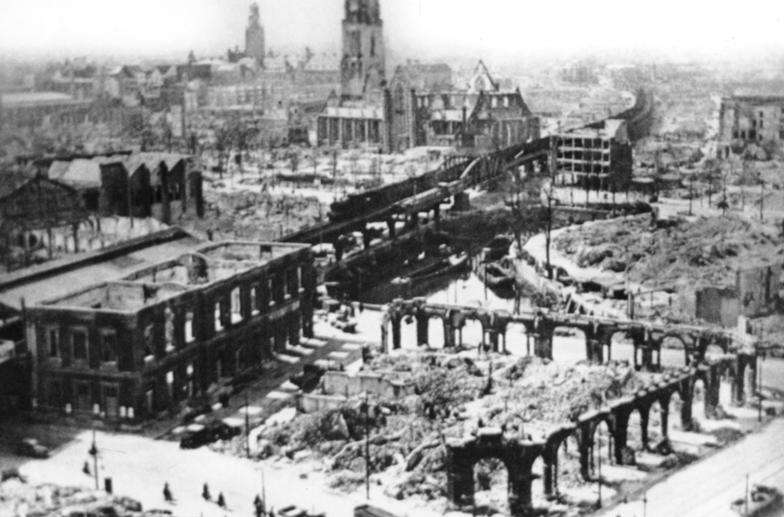
Rotterdam’s railway station after the blitz
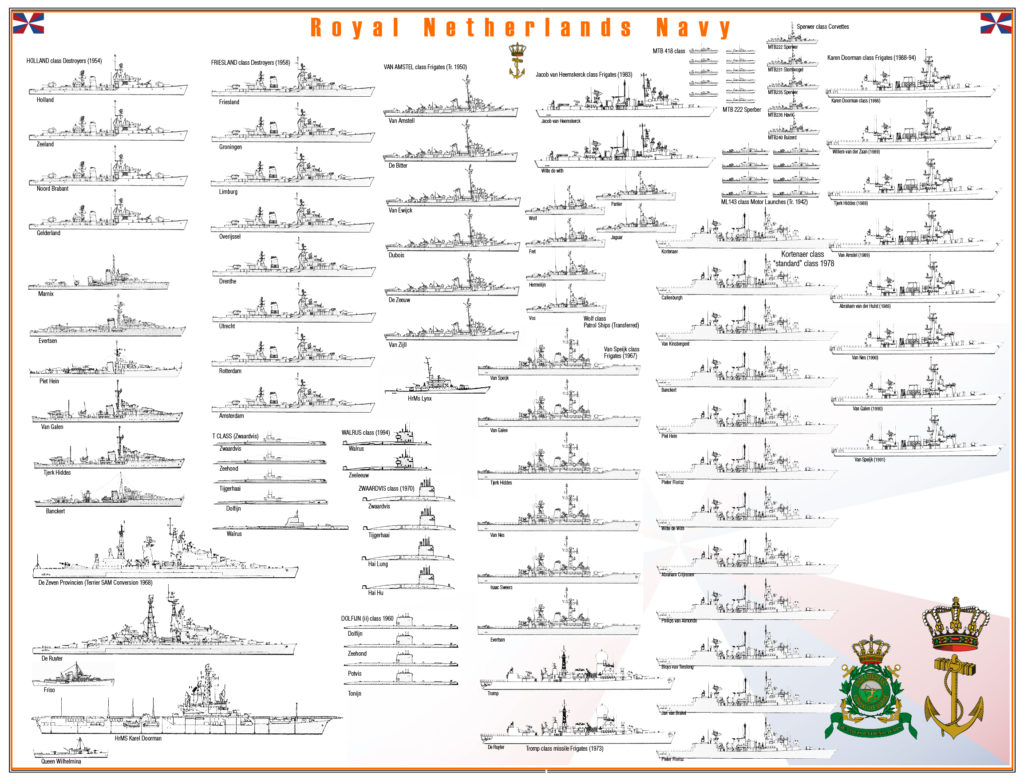
Cold War Poster – Netherlands Navy
Articles
- De Zeven Provinciën class Cruisers (1944)
- Friesland class destroyers (1956)
- HNLMS Karel Doorman
- Holland class destroyers (1953)
- CV Karel Doorman (1948)
- Roodfier class Frigates (1953)
- Frigate Lynx (1954)
- Van Speijk class Frigates (1965)
- Tromp class Frigates (1973)
- Kortenaer class frigates (1976)
- Van H. class Frigates (1983)
- K. Doorman class Frigates (1988)
- Dolfijn clas sub. (1959)
- Zwaardvis class subs. (1970)
- Walrus class subs. (1985)
- ATD Rotterdam (1990s)
- Dokkum class minesweepers (1954)
- Alkmaar class minesweepers (1982)
Reconstruction of the Navy
The naval staff immediately seen the emergency of the navy’s reconstruction in a troubled context. A new naval plan was drawn, combining what was learnt in naval warfare, and the experience of the RNN with the Royal Navy and in the far east, notably losses reports. However it only materialized in 1950. On of its immediate consequences was the authorisation of a purchase, still difficult to justify to the parliament in 1950, because it was quite ambitious, however justified by the east indies colonial possessions, and the price of the ship itself – The United Kingdom preferred to sell them at much lower prices than their construction implied because the Navy could no longer afford to maintain them active: It was the light fleet aircraft carrier Karel Doorman, first and only of this time in the Netherlands (although Dutch crews operated two escort carriers during the war under British flag). Therefore operational experience was already there, something which weighted in the balance. Before the “new” Karel Doorman was purchased, crews had been training throughout WW2 on the Galida, and the Nairana loaned from 1946 under the name of the famous WW2 admiral. The 13,820 tonnes escort carrier was used until 1948 and then returned to UK, resold and converted as a merchant vessel, in which state she served until 1971.
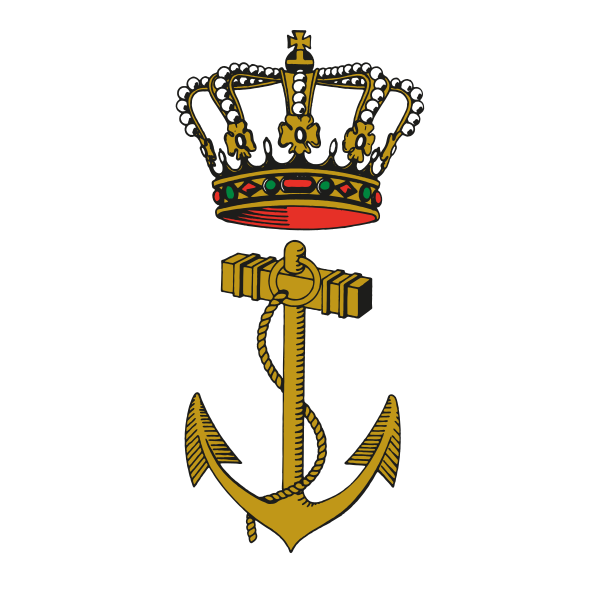
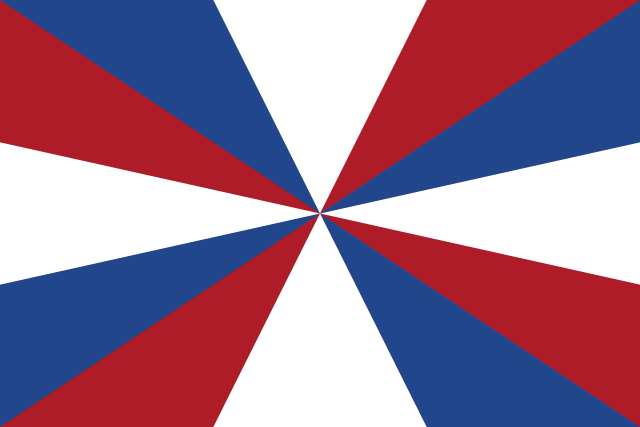
In addition, authorization was also given to complete two large cruisers, in construction since 1939, with a modernization to be used as escorts for the new carrier, and create in effect a task force (De Zeven Provincien class). Also, many other ships were aqcuired or prurchased: Six R, Q ans S class British destroyers, some already operated in WW2, the completion of an older Dutch DD, HX-4 Marnix, several T-class subs and the modernization of the three surviving O-21 class (launched 1939-41), a Frigate (Johan Maurits Van Nassau, ex HMS Ribble), three wartime Dutch Gunboats (Flores, Van Kingsbergen, Van Speijk), a minelayer, Willem Van de Zaan (1938), reclassed as a frigate in 1953, a 1938 emergency program gunboat “C”, eight Bathurst class ex-Australian minesweepers (Ternate class Corvettes). Still extant and modernized after the war were the 4000 tonnes cruisers Jacob Van Hermskerck and Tromp, Five Jan Van Asmtel class minesweepers (one scrapped 1946, the others BU 1961). All the extant ships were scrapped in 1945-47.
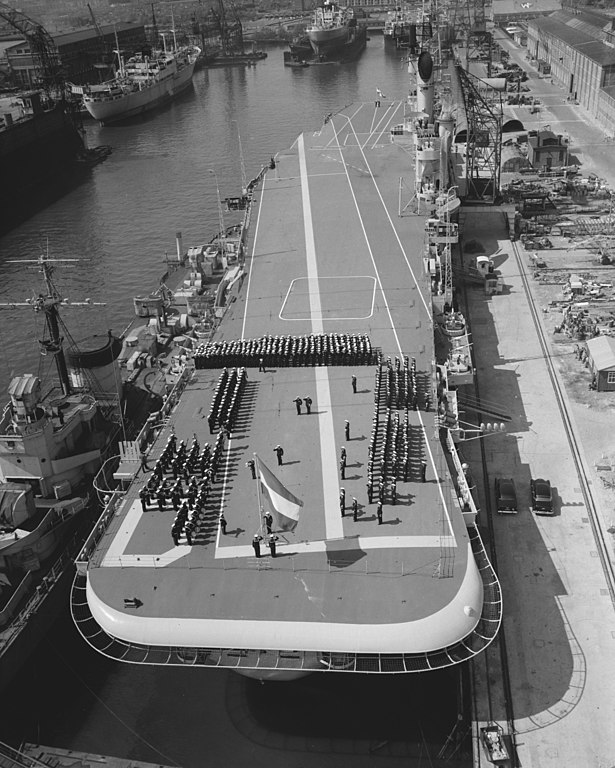
HRMS Karel Doorman
As it went during this reconstruction, aside clearing minefields, free harbours or any obstruction, get equipments, and repair shipyards as no naval construction could start before awhile, the Navy acquired many ex-British and ex-US ships (the latter often on loan) to gain expertise, in particular to share tasks of ASW warfare; Soon, decision was made to develop local electronics industry to provide newly built ships, but delays meant new ships were delivered with empty masts for some time. However on the long run it proved a wide decision, with good quality equipments soon recognised also as such on the international market. As for shipyards, and intense collaboration with British ones helped to solved many issues and speed up recovery of the local shipbuilding industry, as part of NATO rewards. This assistance started with the De Zeven Provincien cruisers and went on on the Holland class destroyers.
Meanwhile, relations with its colonies for the Batavian kingdom changed dramatically, with the Republic of Indonesia being established just two days after the Japanese surrender. By this, colonial authority vanished and after four years of bitter fighting, this was the turn of Indonesia.
Part of the Dutch Navy stationed in Netherlands New Guinea was even turned over to the Indonesian government in 1962. Newt, followed a campaign of infiltrations by Indonesian Forces supported by Soviet armaments, repulsed by the Dutch navy. Infiltrations ordered by President Sukarno to join these territories to Indonesia.
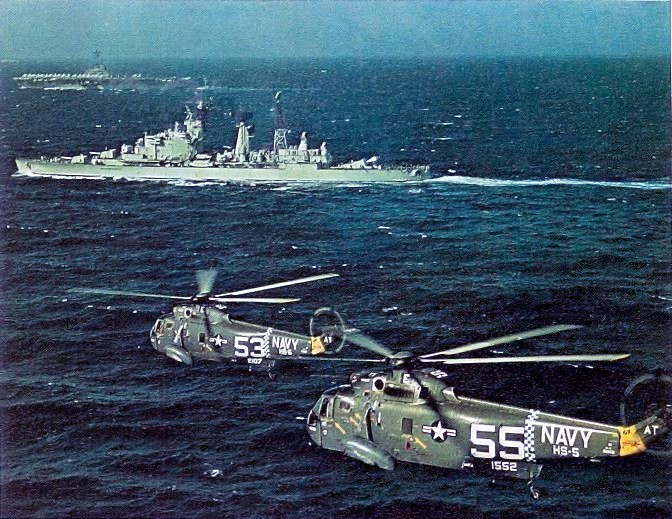
HTMS De Zeven Provincien and USS Essex in 1967
NATO
Althought there was no obligations for the Netherlands by joining NATO to drop their colonial possessions, but colonial wars became a burden. An active member from 1949 as well as in the early EU through treaties, the Dutch Navy received a reorientation towards ASW warfare in particular inside NATO. The navy was given two areas of responsibility, through the blue water navy east Atlantic command (possible with an aircraft carrier, two cruisers and several modern destroyers), still concentrating on ASW duties within this command, and on the other side, defend the shipping lanes and harbours along the North sea coast by providing a potent hunter-killer group. The Karl Doorman was therefore modernized in this direction, modelled after the recent Essex class ASW conversions in the USN. In addition MDAP provided many minesweepers, built locally or in the US and fully funded as well as small frigates.
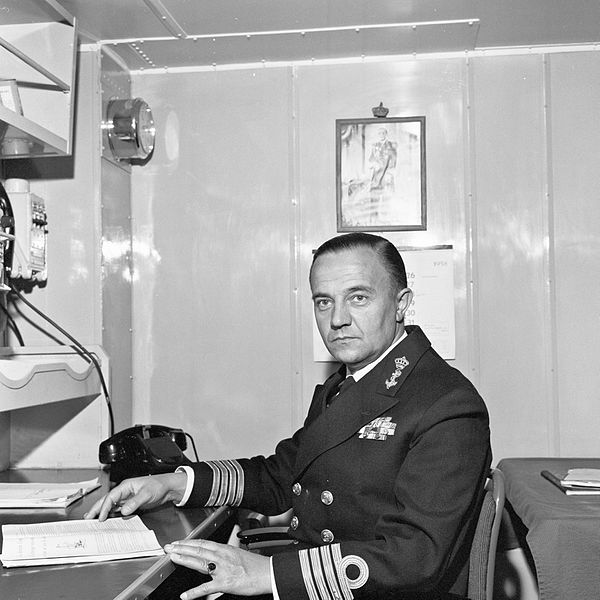
Piet de Jong, commanding officer of HNLMS Gelderland in 1958
By the end of the 1950s the initial naval plan was complete and older ships has been either scrapped or returned. Decision was taken to develop Den Helder as the main Dutch navy naval base with a gigantic task ahead; Repair and restore, and then expand the base drastically. A new harbour was then constructed using the mudflats east of the port to create a very large additional basin, with fingers piers on each side. The west old harbour was then closed off and filled to provide space for new buildings and installations. There, not only all the new large units of the fleet would be built, but the centralized command of the Royal Netherlands Navy was based here, with the Task group command.
The 1960s saw the golden age of cold war Royal Dutch Netherlands Navy, with a rather large blue water navy, comprising the aircraft carrier HNLMS Karel Doorman, two large light modern AA cruisers, 12 modern destroyers, eight submarines, six frigates and many minesweepers.
Smaller units were placed in local bases at Amsterdam, Rotterdam and Flushing. In the 1960s the situation changed little and the navy adopted Leander class frigates to replace ww2-vintage ex-US escort destroyers. The fleet received a new support ship, the Poolster and the Karel Doorman, badly damaged by a fire in 1968 was repaired and sold to Argentina. Instead, the navy adopted eight long range French-built Breguet Atlantique patrol aircrafts. In the 1970s the two De Zeven Provincien cruisers were sold to Peru. The “old guard” went, and the first large missile frigates entered service. A new era began.
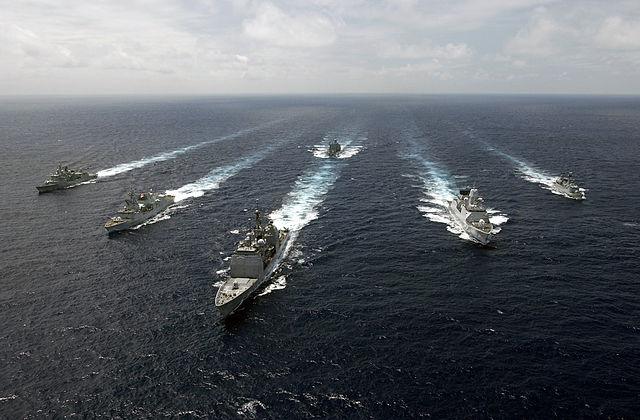
Dutch frigate HNLMS Evertsen (F805) with NATO Maritime Group (SNMG) 1 transit in formation for a photo exercise in 2007.
The 1974 fleet plan
This year a plan was formulated, asking for 23 major surface ships in three task groups, plus a squadron of submarines (6), and MCM (mine warfare) crafts, 30 in three groups.
-The two main task forces comprised a flagship, new missile frigate (Tromp class), six standard ASW frigates, and a suport ship, to operate in the east Atlantic.
-An ASW task force headed with a single standard converted AAW frigate, and six Van Speijk class ASW frigates for the Channel command.
Also came replacement for the old Dolfijn class, replacement planned as the Zvaardvis class submarines, of a brand new generation. The two mixed MCM groups would operate off the Netherlands coast and third group in the north sea under CINCHAN command.
In 1981, the plan was modified as two frigates were sold to Greece, while on the stocks. Due to the increasing aerial threat of the Soviet Union, the new two replacements asked for were planned as AAW frigates and soon joined by the new “M” class frigates tailored for the north sea.
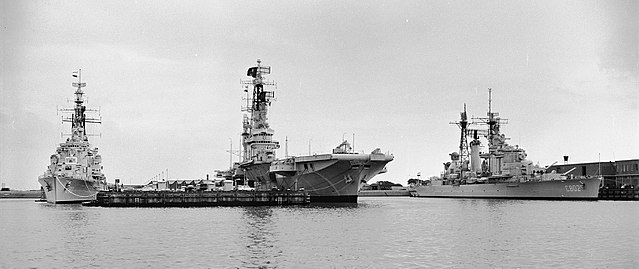
The Dutch Task Force in the 1960s: HtMs De Ruyter (left), Karel Doorman (center) and De Zeven Provincien (right).
The 1984 fleet plan
This ten-year plan was a post-crisis one, somewhat less ambitious. First it was to provide replacement for the old Roodfier class frigates, and it was decided to reduce cost to stick with standard frigate programme, with a twist as the Rhein-Schelde Verolme shipbuilding company collapsed in 1983. Further orders of the standard (Kortenaer class) also were compromised in 1987. The “M” class (Karel Doorman class) were brin forward to replace the Roodfier, immediately stricken to partly finance the replacement program, with four more options to replace the Van Speijk class. Also were ordered the new Walrus class attack submarines. Also was planned a major modernization in 1988 of the the two Tromp class frigates, but replacement was planned with the newt batch of Kortenaer class frigates, more versatile. Also the initial provision of tripartite mine hunters was scaled up and a new class was to be started in 1988.
This plan was however modified in 1986, consequence of the international crisis, budget cuts calling for twenty ships, with only sixteen operational, whereas relatively recent vessels were sold: The four van Speijk, after some reserve were sold to Indonesia, and five of the new minesweepers were also placed in reserve while the Tromp modernization program was curtailed and only one was taken in hand for a more modest upgrade, and two Kortenaer class ships missed their upgrade “capability upkeep program” or the installation of CIWS. The third batch of Walrus class subs was also cancelled.
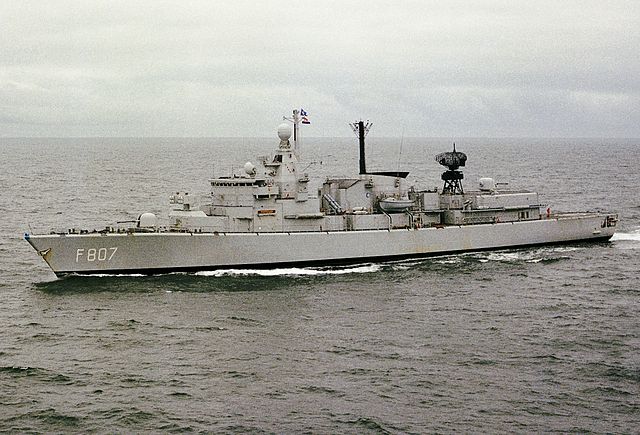
Kortenaer “standard” class frigate in the 1980s
The Dutch fleet Today
Since the end of the cold war, a white paper asked for further reductions: This was a modified version of the 1989 ten years naval plan, and this time it was decided to not modernize any ships, while the “capability upkeep program” was to be capped to six Kortenaer class standard frigates. The 1991 plan planned for 1996 a fleet reduced to two task groups, each led by an ageing Tromp class frigate, a single AAW Hermseerck class frigate, four “M” class (Karel Doorman), three standard class (Kortenaer), three subs and a fast support vessel. The third “reserve” task force mobilized in case of war comprised four mothballed standard frigates, to be stricken in 2000. Six of the Alkmaar class minehunter was maintained in service.
However soon, political changes further drastically reduced these figures. The Kortenaer class were disposed of prematurely, three sold to Greece and the others disposed of form more sales from 1996.
In 1994 a new white paper called for a new peacetime structure compatible with NATO new requirements. It was calculated that the navy still needed no less than twelve operational frigates to maintain deployments for the NATO standing forces, channel and north sea commands, and east indies.
Command Structure
Naval squadron
This is the main bod of the fleet, comprising all surface combatants, including the replenishment and support ships, notably for the amphibious forces. As of today, the RNN holds the NATO post of COMBENECHAN, one of the three senior positions in the Channel command, and the structure of postwar era was based on four maritime regions, Ijmond (HQ Amsterdam), Rijmond (HQ Rotterdam), Texel (HQ Den Helder NB), and Schelded (HQ Vlissingen). The West Indies HQ is Curaçao.
Other units:
Mine Detection and Clearing Service: This force comprised minesweepers and minehunters, command, support and training.
Hydrographic Survey
Naval aviation: Two helicopter squadrons
Netherlands Marine Corps:
-Marine Training Command, former Groep Operationele Eenheden Mariniers
-Two Operational Marine Combat Groups (1 MCG AND 2 MCG)
-One Maritime Special Operations Force (NLMARSOF)
-One Surface Assault and Training Group (SATG)
-One Seabased Support Group (SSG)
-One rifle company (32 Raiding Squadron.), Aruba
Netherlands & Dutch Caribbean Coastguard
Placed under thre navy operational control.
Royal Netherlands Navy Submarine Service
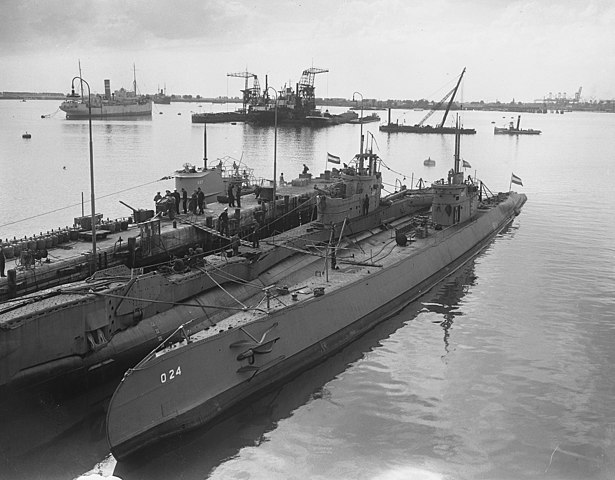
HNLMS O 24 moored alongside two other OZD submarines in 1949
The Royal Netherlands Navy Submarine Service (Onderzeedienst abbreviated as OZD) is a department responsible for the deployment of Dutch submarines established outside the Torpedo Service on 21 December 1906, merged with the Mine Service on 15 July 2005. In 1905 it saw its first commissioned submersible, HNLMS O 1. The service is in charge of the equipment, supply and training. During WW2, the RNN operated about fifteen submarines, many taking part in hunting missions in the pacific, atlantic and mediterranean. During the cold war it was rebuilt with leased British and American submarines, before launching new construction programs.
Netherlands Maritime Special Operations Forces (2013)
The Netherlands Maritime Special Operations Forces is abbreviated NLMARSOF, or MARSOF. This is the special forces unit of the Marine Corps, one of the three principal units used for special operations with Korps Commandotroepen and Brigade Speciale Beveiligingsopdrachten, Royal Marechaussee, a kind of Gendarmerie elite. One of its tasks includes counter-terrorism overseas and at home, carried by sea. It was created in 2013 with the fusion o the Unit Interventie Mariniers (UIM) and Maritime Special Operations company.
Netherlands Navy Air arm
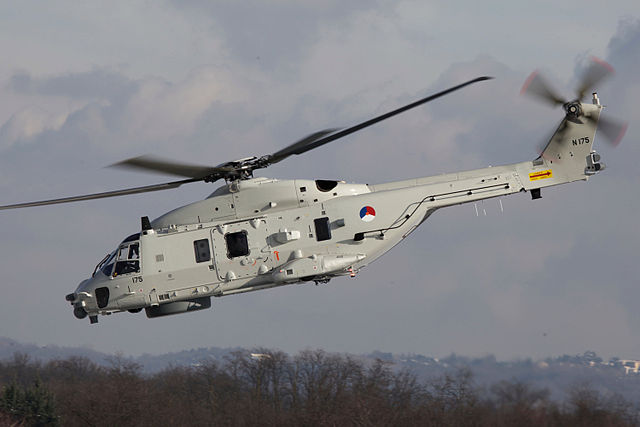
Royal Netherlands Navy NH-90 NFH at De Kooy Naval Air Station
As of today, the RNN operates:
-13 LRMP (Long Range Marine Patrol) Atlantique-2 twin turboprop aircraft
-20 NH90, including 12 NATO Frigate Helicopter (NFH), 8 transport (TNFH) for the Marine Corps Air Lift Helicopter Squadron. As planned in 1974 program, 36 helicopters were operated.
In 2012 an Apache attack helicopter was tested by the Royal Netherlands Air Force for deck landings on the assault ship HNLMS Rotterdam while upgrade to the AH-64E standard was envisioned. HNLMS Johan de Witt and HNLMS Karel Doorman ar also capable of carryong and operate the CH-47F Chinook, upgraded currently to the CH-47F standard.
Composition of the fleet today
De Zeven Provinciën class Frigates (2002)
Four ships, built 1998-2005 and used for anti-air warfare with BMD capability, ASW and with extensive command & communication facilities. The De Zeven Provinciën, Tromp, De Ruyter and Evertsen carried an NH90 helicopter and hangar, an Oto Melara 127 mm/54 dual-purpose gun, several Browning M2 12.7mm machine guns and FN MAG 7.62mm machine guns, a twin Goalkeeper CIWS and missile bays with 40-cell Mk.41, 32 × SM-2 IIIA SAM, 32 Evolved Sea Sparrow SAM, and two quadruple containers with Harpoon SSNs plus two MK32 Mod 9 TTs (Raytheon MK46 Mod 5), to replace part of the Kortenaer class ships.
Karel Doorman class (1993)
The last of the new eight standard serie initially planned were subsequently sold to the Belgian, Portuguese and Chilean navies. These M-Class frigates received extensive upgrades and are planned for replacement in 2028-29. See later, in the cold war section for more ample details.
Holland class PVs (2010)
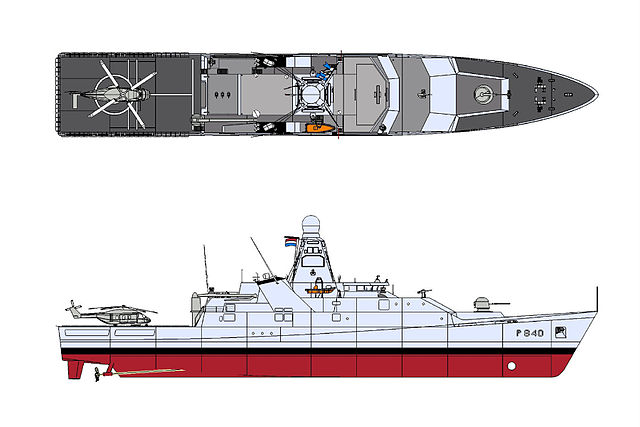
Four Offshore patrol vessel, corvette size, built in 2008-2013, named Holland, Zeeland, Friesland and Groningen. These OPVs have helicopter decks, hangar for a single NH-90 or medium size helicopter, drone, and is a gunboat armed with 1 × 76 mm Oto Melara Super Rapid, 2 × 30 mm Oto Melara Marlin WS, and two 12.7 mm Oto Melara Hitrole NT and six 7.62 mm FN MAG machine gun. They had been used in anti-piracy missions.
Walrus class SSAs (1994)
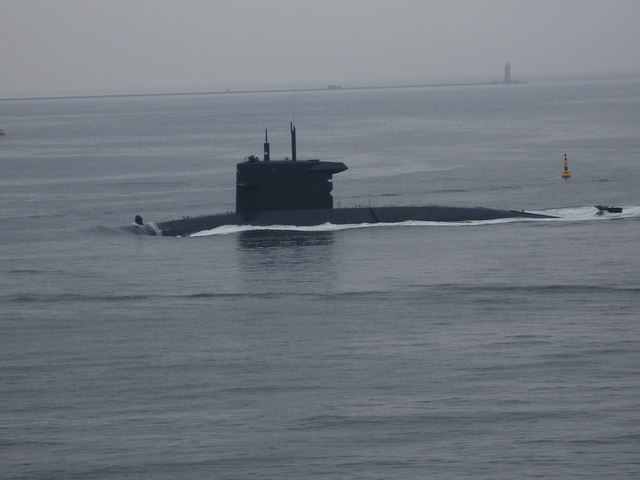
The Navy only maintains four Walrus class conventional attack submarines. These are Multi-purpose diesel-electric powered hunter-killer submarines for deep ocean missions and coastal areas, also able to operate special forces. Modernized 2015–2019, replacement scheduled FY2027.
Misc. Ships
Alkmaar class (1989)
Six minehunter are maintained in service – initially 15 (see the cold war section for more). Replacement FY 2027.
Soemba/Cerberus class (1989-92)
Five multi-purpose Diving support vessel and harbour protection vessels.
Snellius class (2004)
Two modern multi-purpose Hydrographic survey vessels
Mercuur class (1987)
Single Submarine support vessel & MCM command upgraded in 2017.
The RN Marine Corps:
HNLMS Rotterdam amphibious transport dock (1994)
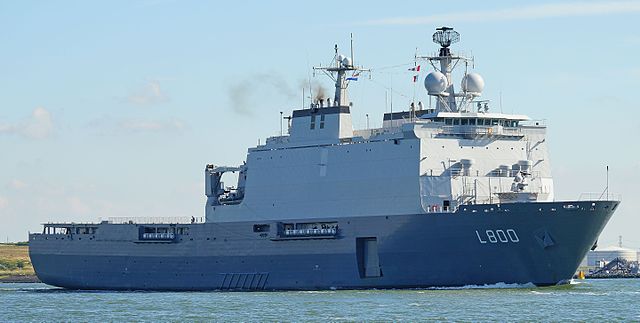
Colaboratively built with Spain, the 16,000 tonnes, 145 x 16 m amphibious transport dock (APD) was launched in 1997 and completed in 1998. She is capable of carrying 600 troops in addition to an air group personnel of 127 and base crew of 133. The fully equipped batallion of Marine can be landed by four LCU/LCM or six LCVPs. The 720 m2 dock is topped by a hangar containing up to 170 armoured personal carriers or thirty Leopard main battle tanks (which had been retired and placed in reserve since). The hangar above contains up to four EH-101 or six NH-90, and the rear section has a two-spot deck and single lift. The ship also has a 100-bed hospital to be deployed in humanitarian missions (which it did).
Other ships
Pelikaan class (2006) Single Multi-purpose logistic support vessel for the amphibious forces stationed in the Caribbean.
LCU/LCM and LCVPs landing crafts.
Vehicle force
It comprised nowadays mostly light to medium wheeled vehicles, but no Leopard MBT.
-156 BV206S APC (Mid-Life Update ) – tracked articulated vehicles.
-74 BVS10 APC, same, made by BAE
-20 Bushmaster MRAP
-4 Leopard BARV (beach armored recovery vehicles)
The Marine troops could also be carried and supported by a part of the 1275 Iveco LMV-2 AFVs, ordered by the army, likely to replace the 100+ Land Rover Defender, 40 Iveco Daily ANACONDA in the Caribbean, 40 Mercedes-Benz 280 CDI, and about 200-300 Unimog 1.2-ton and DAF & Scania trucks.
Some of these vehicles are towing either the L16A2 81 mm mortar orM6 C-640 – 60 mm commando mortar.
NATO PENNANT NUMBERS:
Carried from 1950 onwards:
Cruisers: C 803 JACOB VAN HEEMSKERCK, C 804 TROMP
Destroyers: D 801 BANCKERT, D 802 EVERTSEN, D 803 VAN GALEN, D 804 KORTENAER, D805 PIET HEIND, 806 TJERK HIDDES, D 807 MARNIX
Submarines: 021, 024, 027, S 801, S 804, S 807, S 812 TIJGERHAAI, S 814 ZWAARDVIS
Frigates: F 802 Jan Maurits Van Nassau, F 804 F 805 F 802 JOHAN MAURITS, F 813 F804 VAN KINSBERGEN, F805 VAN SPEIJK, F 803 FLORES, F 813 BATJAN, F 814 BOEROE, F 815 CERAM, F 816 TERNATE, F 824 WILLEM VAN DER ZAAN
Read More
- https://en.wikipedia.org/wiki/Royal_Netherlands_Navy
- https://en.wikipedia.org/wiki/Royal_Netherlands_Navy
- https://www.globalsecurity.org/military/world/europe/de-navy-cold-war.htm
- http://www.warpp.info/en/m5/articles/german-submarine-exports
- https://en.wikipedia.org/wiki/German_Navy
- https://en.wikipedia.org/wiki/German_Mine_Sweeping_Administration
- http://coldwardecoded.blogspot.com/2013/06/normal-0-false-false-false-en-us-x-none_29.html
- https://en.wikipedia.org/wiki/List_of_German_Navy_ship_classes
Cold war Dutch Capital ships
 Karel Doorman (1948)
Karel Doorman (1948)
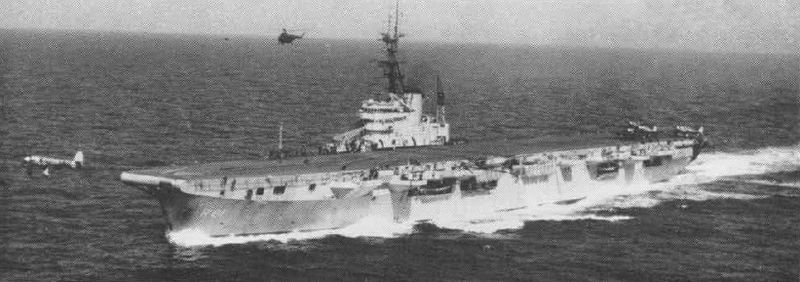
The HMS Venerable was one of the last light fleet aircraft carriers to be operational in time for WWI, as she entered service in January 1945. In 1947, like many other Royal Navy carriers she was considered surplus and in the context of post-war budget cuts, she was mothballed. Like many other carriers of her class and those close to it, she was proposed on sale by the British Government at very affordable price (contrary to the USN which kept its own in reserve).
This allowed many naval forces to get their first carrier, and the Netherlands were no exception. She met the 1950 naval plan and was purchased on the first of April 1948. She was renamed like the former escort carrier she replaced, Karel Doorman, the WW2 admiral which commanded the allied naval forces in 1942 and perished at the battle of Java.
The carrier also started with a crew experienced already onboard the carrier of the same name, plus personal which served on the Nairana, Colossus and Gadila. The Nairana served as Karel Doorman indeed, loaned from 1946 to 1948.
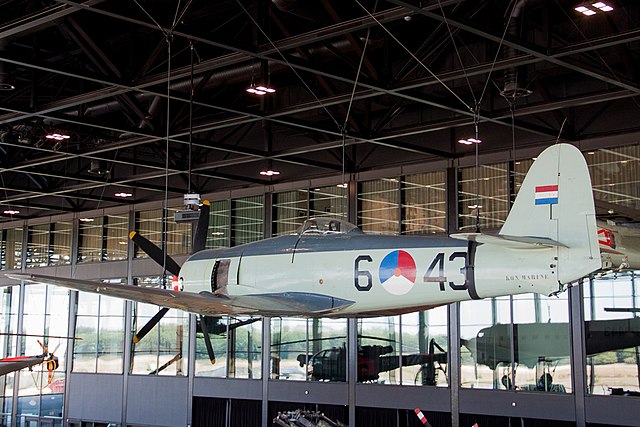
Dutch Sea Fury at the former AFB Soesterberg.
For practical reasons, the aircraft park consisted in Sea Fury FB 11 and Firefly ASW aircraft purchased at the same time. In addition 23 Sea Fury FB 15 were later built under licence in the Netherlands.
In the 1953-54 a deep survey of the ship was done to decide its fate, either scrap it or modernized it. The latter was chosen after a report was done on the excellent state of the ship, hull integrity and excellent conditions of the machinery and equipments. The modernization program was a massive undertaking destined to modify the hull and flight deck in order to operate jets. The yard chosen, Wilton-Fijenoord worked on blueprints from similar conversions done in the UK.
The refit lasted from 1955 to 1958. She emerged with an enlarged (165.50 m long), much reinforced and angled deck, and steam catapult to port forward, new mirror landing sight, allowing simultaneous recovery and launch of heavier jets. An arrester gear fitted as well, and new tanks for jet gasoline. The internal arrangements were completely revised and overhauled as well.
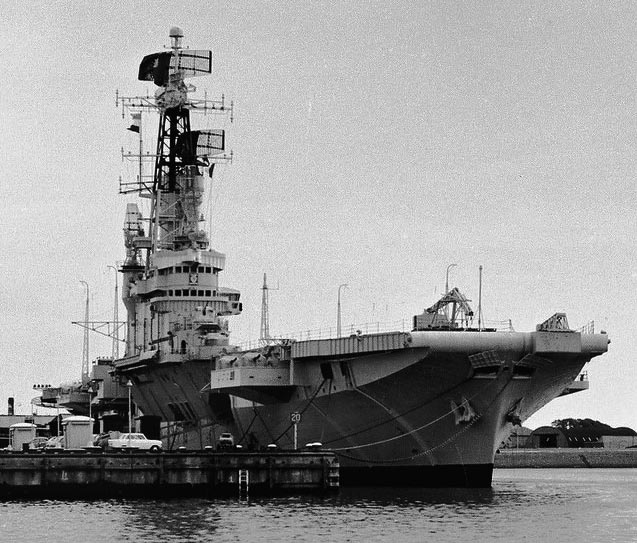
The electronics suite was also considerably modernized, entirely home-built, with a derrick style lattice four legs mast and taller funnel, with a LW-02 air surface search antenna, LW-01 long range surveillance radar and DA-01 combined air/sea search radar, VI-01 nodding height finder, new sensors and ZW-01 navigation radar above the bridge. The AA was also modernized, with 12 single 40 mm Bofors mountings, on each quadrant and either end of the island.
The port forward pair was later removed to clear the end of the angled deck. Her air group changed for a squadron of Sea Hawk FGA 6 fighters and a squadron of TBM-3 Avenger, soon in the early 1960s, replaced by eight S2F-1 Tracker ASW planes and six HSS-IN Seabat helicopters. She was indeed refitted accordingly to the last naval plan, to be the center of an ASW hutner-killer group.
In 1965-66, the Karel Doorman was reboilered while in drydock, with units from the uncompleted carrier Leviathan, of the same class. However on 29 April 1968 a fierce boiler fire ravaged the interior. She was repaired but at that time, priorities had changed, and the next year she was sold to Argentina, after receiving more modern electronics and receiving the turbines of HMS Leviathan as well, becoming ARA Veinticinco de Mayo, which illustrated in the Falklands. She was discarded and decommissioned in 1997, quite a carrer.
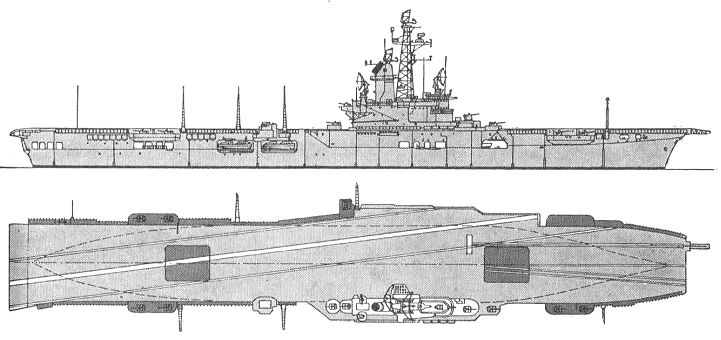
HrMs Karel Doorman as whe was after reconstruction in 1965
Specifications (1958)
Dimensions: 211.3 x 24.4 (37 deck after rebuilding) x 7.6 m
Displacement: 15.892 tonnes standard, 18,986 tonnes FL
Powerplant: 2 shafts Parsons geared steam turbines, 4 boilers, 40,000 shp, 23.5 knots 12,000 nm range
Armament: 12 x 40mm AA
Electronics: Radars LW-01, LW-02, DA-01, Guiding VI-01, ZW-01
Air group: 21 aicraft (see notes)
 De Ruyter class cruisers (1953)
De Ruyter class cruisers (1953)
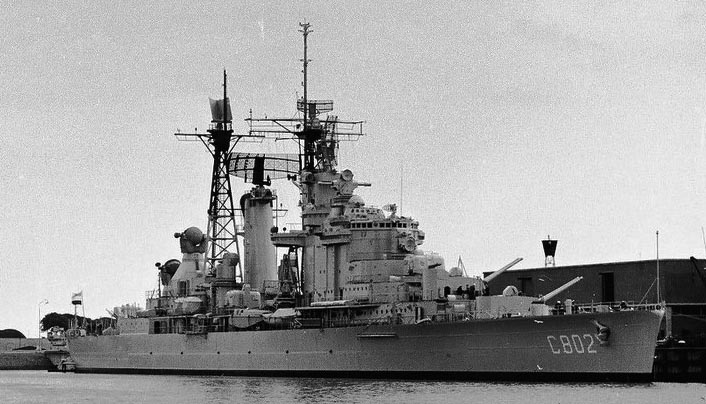
The very interesting cruisers were one of many projects to bolster the Dutch East Indies Squadron, facing the Japanese Fleet. Tne other project was a battlecruiser, which never came to fruition. But two large light cruisers were also planned, to replace the 1920s HTMS Java and Sumatra. These the De Ryuter class cruisers, a radically enlarged version of the prewar HTMS De Ruyter. Both were started at Wilton-Fijenoord (De Zeven Provincien) and Rotterdam (Eendraght), laid down in September and May. However, little work has been done when the invasion began on May, 10, 1940.
They could not be launch and therefore evacuated and both were captured as they were by the Germans. The German Navy supervised the pre-launch completion of the hull by orderding an “atlantic bow”, with more flare and raked. Later, as work progressed very slowly plans has been to launch her to block the Port entrance of Rotterdam but it never happened. Her sister ship remained on slip, with too little work for any hope of launch completion by the end of 1944. The Germans deided to removed all equipments to prevent their completion as the allies advanced and wrecked the yards.
As the war ended in Europe, the allied and new Dutch government assessed what could be done, there has been indeed plans to mobilize ships to be sent in the Pacific. Launch and Completion was postponed until 1947 but it was agreed the design was completely obsolete. New plans were established by the british, putting the emphasis on AA in the idea of using them as task force escorts. The original eight 6-in (152 mm) guns were kept but fitted with a new high elevation mount of 60°. They were partly manufactured at Wilton-Fijenoord, under licence by Bofors. They were fully automated, allowing 15 rpm and radar-guided.
The secondary battery was also brand new and comprised four twin Bofors 57 mm/70 AA guns, in tri-axial stablized mounts, also radar-guided, and eight single Bofors 40 mm/40. There was also a 103 mm flare launcher. The powerplant was completely revised, from separated rooms with three boilers rooms and three turbines, to a more united system with two De Schelde/parsons geared steam turbines four boilers 85,0000 shp for a top speed of 32 knots. The internal layout was also completely revised, in the arrangement of magazines and hoists and boiler trunking.
In the end they were fitted with two tall funnels instead of the original one, and tall tripod lattice masts supporting the radars -locally designed and built- in which the funnels were embedded, a bit like French “macks”. The bridge was also considerably enlarged to integrated general C&C, ASW task group command and admiralty facilities. To reduced topweight (1,000 tonnes more than originally planned), welding and aluminium were used everywhere possible.
Of course of armour of fany sort was used. Also the electric generators (much more powerful by the way) were spread to avoid a single hit disability, a war lesson, and using AC current instead of DC. The dispersal of living quarters, and latest damage-control techniques were also integrated, drawn from war lessons also. Air conditioning and ventilation was also considerably improved. The ships after all were still planned to serve in the west an east indies.
This was pretty constistent but still “light” for nearly 190 m long ships, displacing 11,850 tonnes fully laden, which were launched respectively in December 1944 and Kijkduin (ex-Eendracht) in August 1950. Compelted in December 1953, De Ruyter was renamed, ex De Zeven Provincien. In December De Zeven Provincien followed (ex-Kijkduin). The ships underwent considerable changes during their career. To ensure their service globally both ships were tested in the arctic and equator.
In the 1960 it was envisioned to convert both ships with Terrier missile for north atlantic service. Budget cuts and life expectancy however limited this conversion to De Zeven Provincien only. The plating of the main deck to the forecastle deck because of the extra depht needed to installed the missile magazine ring. All aft 6-in, 57 mm and 40 mm guns were removed and the superstructure completely modified. The terrier Mark 10 SAM system (long range) comprised 40 missiles in a barillet and a new mainmast was erected with the 3D SPS-39 radar and guiding system placed well behind the aft funnel, on which was placed the LW-01 radar. Thos was completed by a SW-01 unit and an M25 and M45 sets, plus two SPG-55 for each of the Terrier missiles.
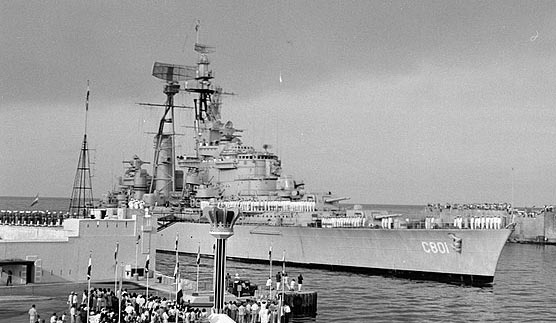
De Ruyter carrying the royal family at St. Annabaai.
In 1971-72, the last modification, the obsolete VI-01 was removed and DA-01 added relocated in place in its place toreduced topweight. The SPS-39 scanned was also replaced by an SP/SPA-72 planar antenna and the Corvus chaff system added abreast the bridge. These cruisers served as quadron flagships throughout their career, until replaced by the Tromp class guided missile destroyers.
In 1973, De Ruyter, still in its original conventional configuration was sold to Peru, and became Almirante Grau. Her sister-ship was also sold in 1976 and became Aguirre in Peruvian service. They were decommissioned in 1999 and 2017 respectively, quite a remarkable service for ships designed in 1937.
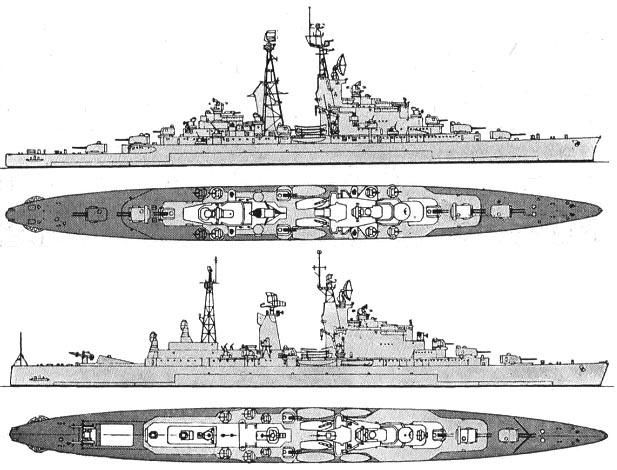
blueprint and evolution of De Ruyter class – Conway’s, from navypedia
Specifications
Dimensions: 182.4/187.3 (185.7) x 17.3 x 6.7 m
Displacement: 9,529 tonnes standard, 11,850 tonnes FL
Powerplant: 2 shafts De Schelde-Parsons geared stem turbines, 4 boilers, 85,000 shp, 32 knots.
Armament: 4×2 152 mm DP (6-in), 4×2 57 mm AA, 8x 40 mm AA, see notes
Electronics: Radars LW-01, DA-01, VI-01, M25 and M45 (guidance), see notes.
Cold war Dutch Destroyers
 Banckert class (Transferred 1945)
Banckert class (Transferred 1945)
HtMs Banckert, Evertsen, Van Galen, Piet Hein, Tjerk Hiddes, Kortenaer, Marnix
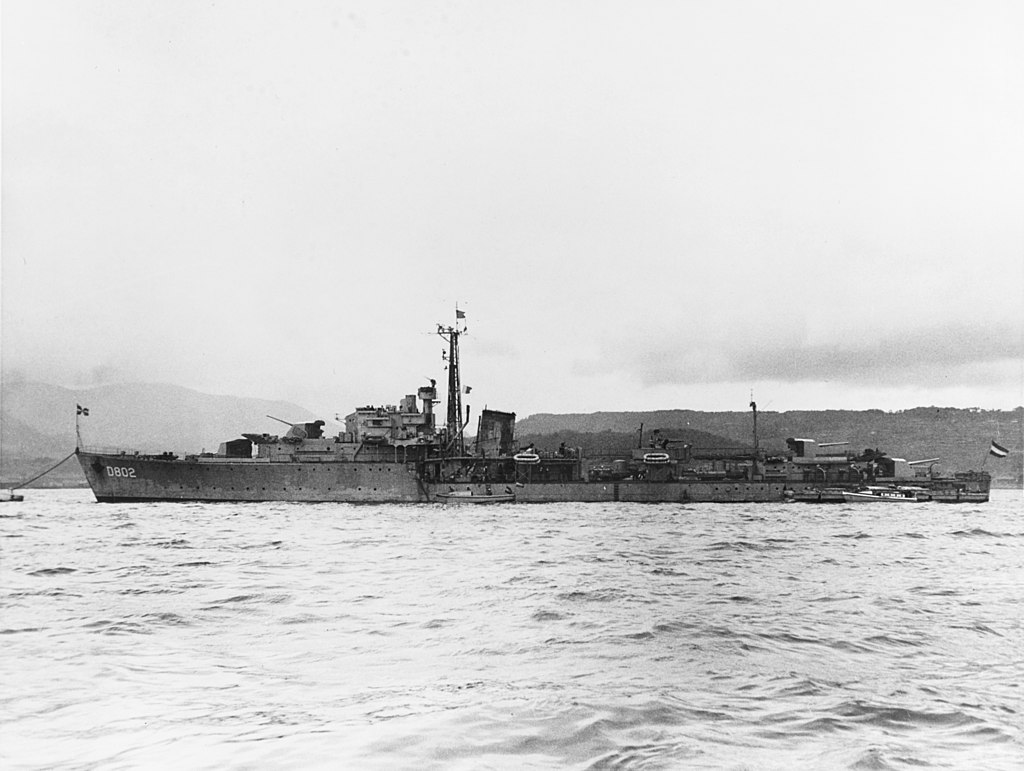
HrMs Evertsen off Yokosuka in 1951
By simplification these different destroyers are studied here in one go, based on their origin: They were all British WW2 destroyers, built in 1941-43, of the Q, N and S class, 1760-1796 tonnes. The first, Tjerk Hiddes and Van Galen were transferred in 1942 for the Free Netherlands navy, and served with distinction, but the other four were transferred in 1945, the last, Marnix, in 1947. They were the ex-Quillian, courge, Serapis, Sentinel, and Noble, Nonpareil and Garland (ex-Polish) for HtMs Marnix.
She was rebuilt as a training ship the next year and stricken in 1964. No changes for all but three, Evertsen, Kortenaer and Piet Hein, overhauled at Rijskswerk Willemsoord from 1957, and classed as fast ASW frigates. They showed in particular a flying pad over the torpede banks for an helicopter.
After reconstruction, they had four 120/45 QF Mk IX, a twin 40/56 Bofors Mk VIII/IX, four twin 20/70 Oerlikon Mk IV, two quadruple 533 TT four DCT and four 2 DCR (70 – 130 DC) and for electronics carried a radar type 275, type 277P, type 283, type 291M, and a type 144 or type 146B sonar. They were stricken from 1957 (Banckert) to 1964 (Marnix) but Tjerk Hiddes was resold to Indonesia in 1951.
Van Amstel class (DE, transferred 1950-51)
Van Amstel, De Bitter, Van Ejwick, Dubois, De Zeeuw, Van Zjill.
These were Six WW2 ex-Cannon class (DET type) escort destroyers purchased on MDAP funds on 1950. The first four that year and the others in 1951. They kept their unique torpedo tubes bank for some time but it was removed as most of the AA guns, 20 mm Oerlikon. Their main advantage for ASW warfare was their ASWRL hedgehog, four depht charge throwers and racks. They served until 1967 and were returned to the USA for scrapping. All but the first has been built by Federal, Kearny NyD.
 Holland class (1953)
Holland class (1953)
Holland, Zeeland, Noord Brabant, Gelderland.
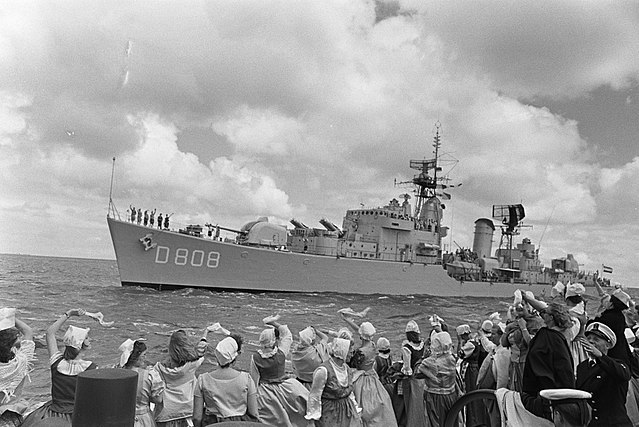
HTMS Holland off Chatham
These four destroyers still had some superficial classic WW2 DD looks but they were the first in Europe planned and completed without any torpedo tubes. They had been indeed designed in 1947 as pure ASW destroyers. They were to protect a task force agai,st submarines all around, while the De Ruyter clas cruisers provided AA cover (as the carrier’s air group). This was their hunter-killer group duty, but they were also intended to carry out missions singly. To defend the fleet against light surface forces showever they still had four Bofors QF 120 mm guns, in dual automated turrets.
They elevated to 85° and were capable of 45 rpm, radar-guided. AA was reduced to a single 40 mm and originally five 57 mm guns, but the core of their capabilities were represented by two quadruple 324 mm ASWRL at the front, several ASW mortars and the British squid system were also planned, but ultimately only the Bofors 375 mm Rocket Launchers were considered, installed on a raised platform behing the forward turret.
When the design was accepted, they were ordered in 1948 at Rotterdam DD (the first), Royal Schelde (the next two) and Wilton-Fijenoord (the last one), laid down in 1950-51, launched in April 1953, June, November and September respectively. They were completed in December 1954 (Holland), March, June and August 1955 for the other three. Delays in the early phase were caused by the state of Dutch infrastructures in 1950. To speed up completion they used equipments from the uncompleted wartime Isaac Swers class DDs, now mothballed. The class originally comprised twelve destroyers, the other group was modified and became a separate class (see below).
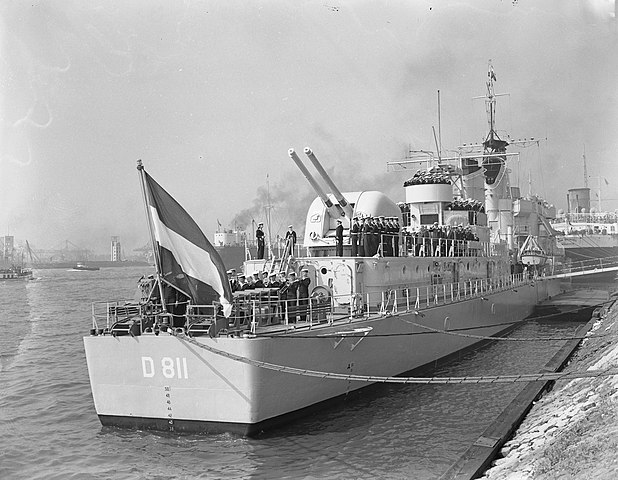
HtMs Gelderland aft section, Rotterdam
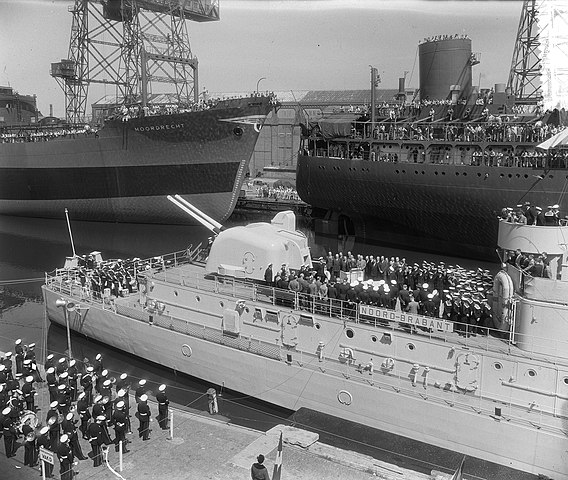
HtMs Noord Brabant at Vlissingen, showing her aft section
Powerplant-wise, they had been fitted with the Swers class engines which were smaller, so their performances remained modest, but good, at 32 knots. On trials, they proved able to even reach 40 knots, a testiment to their hull lines, but with the “cheating” of having no equipment present yet. There was some armour protection on the vitals but they were structurally part of the hull, made with high-tensile A52 steel weherver possible fornthe structure and armor plating, and aluminium everywhere else. A great attention was paid to watertight subdivision also. Electric welding was also used for construction, quite extensively, also to save weight. The adoption of the funnel embedded in the lattic mast was the result of wind tunnel tests. The configuration was adopted for many other designs. The aft mast however was placed behind the aft funnel, closer to the aft turret, which rested on the rear deckhouse. When completed, no home-built radar was ready yet.
They were fitted aft with a pole mast, later replaced by a lattice when electronics was installed in 1957-58. This consisted in the ZW-01, M45 radars, and the type 170B and type 162 sonars. So basically the ships operated “blind” for three-four years. The topweight of the electronics made for a drastic choice: The 57 mm mounts were removed and only a single 40 mm Bofors left. There was a proposal to removed their aft turret and convert them to missile, but this never happen. They were disposed of in the 1970s: Holland was sold to Peru in 1978, Zeeland scrapped in 1979, Noord Brabant in 1974 after a collision, and Gelderland in 1973. The latter had its twin turret removed and resued on the new Tromp class missile Frigates.

Profile rendition (navypedia)
Specifications
Dimensions: 109.9/113.2 x 11.4 x 5.1 m
Displacement: 2215 standard, 2765 FL
Powerplant: 2 shafts Werkspoor-Parsons geared turbines, 4 boilers 45,000 shp, 32 knots
Armament: 2×2 120 mm/50 Bofors DP, single 40/70 Bofors SP48, 2×4 375 Bofors ASWRL, 2 DCR
Electronics: ZW-01, M45 radars, type 170B, type 162 sonars
 Friesland class (1953)
Friesland class (1953)
Friesland, Groningen, Limburg, Overjissel, Drenthe, Utrecht, Rotterdam, Amsterdam
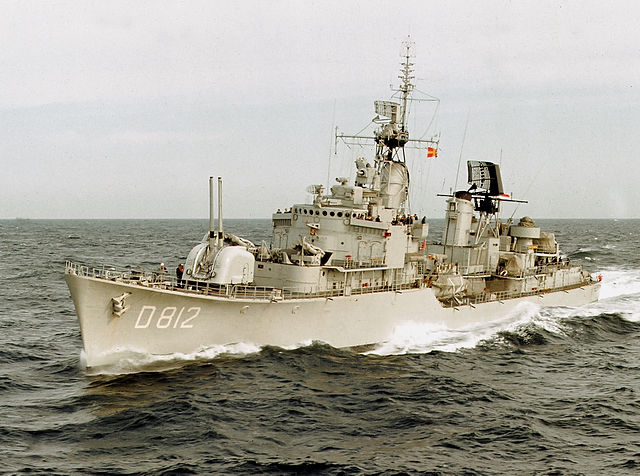
HtMs Friesland in the 1960s
The second group was virtually a repeat of the Holland class. They were laid down in 1951 to 1955, launched 1953-56 and completed in 1956-58. The main difference was their custom-built powerplant, allowing 60,000 shp and a top speed of 36 knots (42.8 on trials).
The powerplant was identical to the Grearing class cruisers, and they were subsequently deeper and wider, also heavier. Their AA was therefore improved, with six single 40 mm Bofors but the rest of the armament was identical to the Holland class, as much of the construction details. The aft structure was modified and lattice masts installed from the beginning.
In 1960, HtMs Utrecht was experimentally fitted back with two quadruple 324 mm ASW TT banks, and Overjissel the next year, but they were ultimately removed as new developments in ASW made them obsolete. The two forward Bofors 40 mm AA guns were removed in the mid-1960s and the AA fire control radar in 1977-78. British sonars were replaced by home made CWE-610 models, same as on the Tromp class Frigates. These destroyers really made the backbone of the Dutch ASW hunter-killer groups well-valued inside NATO. They were all but Friesland (scrapped 1979), sold to Peru in 1980-81 and replaced by the new standard (Kortenaer) class Frigates.
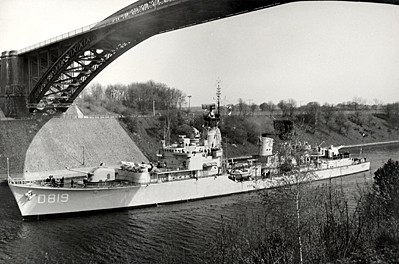
HtMs Amsterdam, D-819 in 1958.

Profile of the class – Navypedia
Specifications
Dimensions: 112.8/116 m x 11.7 m x 5.2 m.
Displacement: 2497 tonnes standard, 3070 tonnes FL
Powerplant: 2 shafts Werkspoor Geared steam turbines, 4 boilers, 60,000 shp 36 knots – Range 4000 nm/18kts
Armament: As Holland but six 40 mm/70 Bofors AA
Electronics: LW-02, DA-01, ZW-01, M45 radars, type 170B, type 162 sonars
Cold war Dutch Frigates
The concept of destroyer was superseded by ASW Frigates due to the context of NATO’s focus on the Soviet submarine threat in the 1950s. Therefore, it became soon apparent that the Dutch Navy soon will have a part to play in it, between the north sea and north atlantic. Its destroyers were kept as escorts for its aircraft carriers, complementary to cruisers, but along NATO’s priority, the Dutch Netherlands Navy will soon have to play its part in combined ASW operations.
Just after the war, there was no design available suited for the task, so the obvious choice was to provide the navy with US aid (MDAP funds), giving birth to the 1st generation of Dutch ASW Frigates, retired in the 1960s: The Van Amstel and Roodfier class. They were all classed as Frigates under NATO pennants F806-811. But of course the game changer was the first Dutch-built Frigates, the Van Speijk class. At the time, nearby Great Britain, always a strong influence, was though after, as a Dutch adaptation of the 1960 Leander class design.
After twenty years of loyal service they were resold to Indonesia. Because in development in the 1960s were a much ambitious endavour: The replacement of the De Ruyter class cruisers with missile frigates: The Tromp class. Also in the 1970s were planned a new generation of cheaper vessels, the Kortenaer class 12 large vessels built over eight years (1975-83), representing the best of European ASW Frigate tech within NATO, also replacement for the old 1950s destroyers.
They are still mostly in service, although the 1980s saw the construction of two more ambitious, larger vessels, the Van Hermskerck class, and eventually the 1990s Karel Dorman class, scheduled to replace the Kortenaer (mostly resold to Belgium and Portugal). As we speak in 2021, the current Anti-Submarine Warfare Frigate program started in 2013 is about to be concluded by the construction of the first ship in 2023. Specs were just precised by the Dutch MoD in 2020.
 Van Amstel class (1950)
Van Amstel class (1950)
Van Amstel, De Bitter, Van Ewjick, Dubois, De Zeeuw, Van Zilj
The first Dutch ASW Frigates were six long-range (mid-atlantic) stock DET type (Cannon class) destroyer escorts of 1942-43 purchased for the first four in June 1950, and May 1951 for the last two. Most has been built at Federal, Newark NyD. Their armament was kept intact, but with some minor changes, notably between De Bitter & Van Amstel and the rest. However all other specs were identical to the US ships.
Armament: 3×3-in guns (76 mm) DP, 3×2 40 mm AA, 8-10x 20 mm AA, 1 Hedgehog ASWRL, 4 DCT, 2 DCR, triple 21-in TTs (none on Van Amstel and De Bitter). These TTs were later removed, as seemingly obsolete to deal with the new generation submarines. Also in 1959-61, most of the 20 mm were also removed, also judge obsolete to deal with jets. In December 1967, they were all returned to the USA and scrapped on arrival.

Conway Profile of De Zeeuw in 1966
 Roofdier class (1954)
Roofdier class (1954)
Wolf, Fret, Hermelijn, Vos, Panther, Jaguar
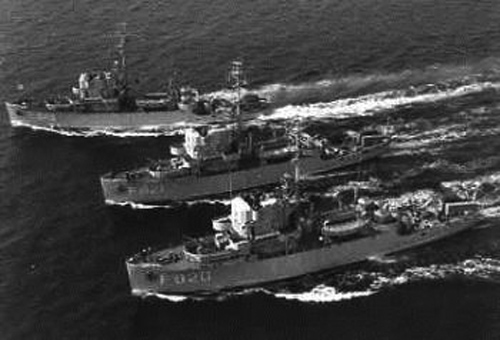
Also provided under MDAP funds to the Dutch Navy, these six vessels (pennants F817-822) were coastal ASW escorts, designed for the slow convoys in the channel and north sea. There was a single squadron of 800 tonnes vessels buuilt in the US (Avondal and General SB) between 1952 and 1954, similar to the Agile class multipurpose vessels of 1944 (originally designed as minesweepers/escorts).
Although much larger than the ww2 flower class they retained their WW2-pattern armament and detection systems but did much more service than the Van Amstel class due to their peacetime tasks, notably fishery protection, well helped by their long range (General Motors diesel engines).
They were sold indeed between 1985 and 1988, which, combined with the fact they were built in the early 1950s (Commissioned March-December 1954). Like the Amstel above, they diverged in armament, Panther and Jaguar having four single Bofors instead of six, compensated for four DCT instead of two on the other four vessels. Their 20 mm AA were retired in the early 1970s. It seems thir modernization was limited to electronics, notably the navigation radar. See also marineschepen.nl, navyinside.nl, NL FFs List
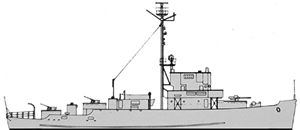
Conway Profile of Vos in 1970
Specifications
Dimensions: 54.9/56.2 m x 10 m x 2.9 m.
Displacement: 808 tonnes standard, 975 tonnes FL
Powerplant: 2 shafts GM 12-567 ATL diesels 1,600 bhp, 15 knots – Range 4,300 nm/10kts
Armament: 1x 3 in, 4-6x 40 mm AA, 8x 20 mm AA, 1 Hedgehog, 2 DCT, Sonar QCU-2
Crew: 96
 HNLMS Lynx (1954)
HNLMS Lynx (1954)
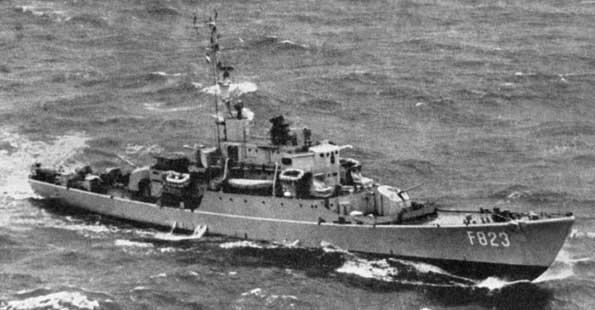
HNLMS Lynx (F 823) Source: seaforces.org
As far as Dutch Frigates are concerned, this ship was a curios standoff design. She was built in the Venice-based Italian naval yard, Cantiere Navale Breda Marghera (Now Fincantieri). She was entirely funded by MDAP. Laid down in July 1953, she was launched in July 1954 and completed in October 1956. HLMNS Lynx was in fact an attempt to test the Albatros design in the north sea, something already done with the closely related Danish Triton class Frigate. So this vessel spent only five years in service with the Royal Dutch Netherlands Navy, before being sent back to the Marina Militare when she was recommissioned in October 1961, as “Aquila”. There, she was reclassified as a Corvette, like the Albatros class and served until the late 1980s.
Specifications
Dimensions: 126.4/134.8 m x 14.6 m x 4.5 m.
Displacement: 4,400 tonnes standard
Powerplant: 2 shafts CODOG 2x WR-21 GT, 2 diesels 28-30 knots – Range 5,000 nm/18kts
Armament: 2x 3 in, 2x 40 mm AA, 2 Hedgehog ASWRL, 2 DCT, Sonar QCU-2
Crew: 109
 Van Speijk class (1965)
Van Speijk class (1965)
Van Speijk, Van Galen, Tjerk Hiddes, Van Nes, Isaac Sweers, Evertsen
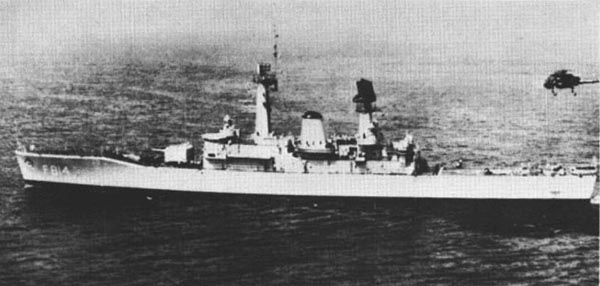
HNLMS Isaac Swers circa 1969 (L&L Van Ginderen via Conways)
When the admiralty decided to start its domestic naval construction program in 1960, to gain time it was decided to take an existing design to spare R&D time and money, and rather adapt the model chosen to Dutch electronics of the time. Basically, soon the Dutch commission turned to the latest kid on the block, the Leander class ASW Frigates (1961) the largest, best and last avatar of the long lineage started with the Type 12 (Rothesay class). The British design was also intended to fill the proper role awaited by NATO for the Dutch Navy in ASW patrols. They also became the first missile Frigates of the Dutch Navy, provided with a better SAM capability even than the Leander class.
Thanks to the adaptation made to the Dutch design, the process was quick and the first ship authorized and laid down in October 1963 at NDSM Amsterdam. Swapping British electronics and electrical equipment to Dutch manufacturers standards took most of the redesign work. Hollandse Signaalapparaten supplied all the electronics, notably their LW-02 long-range air-surveillance radar, DA-02 medium-range air/surface search radar, M45 combined radar and optical FCS for their main guns. Slaved to the Seacat anti-aircraft missiles was the Dutch-designed HSA M44 radar/visual director for elevation and bearing. Ths Dutch system outperformed the british one so two launchers were installed intead of just one each with their own director.
The six ships were built between Amsterdam and Royal Schelded, Van Speijk launched and completed in March 1965 and February 1967 and Evertsen in june 1966 and December 1967 respectively, Isaac Swers being the last commissioned, in late 1968. The first two were ordered in 1962, the next four in 1964. They were also the first to carry an helicopter, a small Westland Wasp, and were tailored to operate with the ASW hunter-killer groups alongside the Holland and Friesland classes.
Mid-life modernization
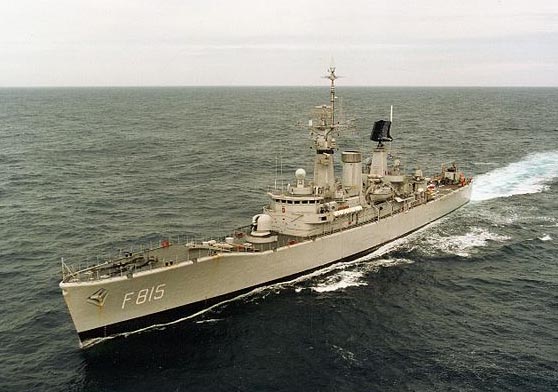
HNLMS Evertsen (F 815) after modernization, circa 1986 (cc)
Plans were drawn for a mid-life refit and modernization in order for them to stay relevant in the 1980s. It was planned in 1974, and changes were considerable, from armaments to electronics. For example, the twin 4.5-inch turret was discarded and replaced y a single, very fast OTO Melara 76 mm gun. Also SSM capabiliy was added by placing two quadruple canisters with Harpoon anti-ship missiles (abaft of the funnel). The old Limbo ASW mortar was replaced by triple Mk 32 torpedo launchers installed abaft the hangar, and the the flight deck modified to hourse and operate the larger Westland Lynx helicopter.
This was helped notably by the elmination of the variable-depth sonar. The ships benefited from the new LW-03 and DA-05 radars but above all, the automated combat management system SEWACO V appeared. The CO (Central Operation) greatly helping the captain decision making process. The power plant was modernized also and extensively automated, but did not changed overall. Automation also helped reducing the crew from 250+ to 180 allowing roomier facilities and better comfort. In 1986-89, the ships were shedeiled for replacement by the Karel Doorman class, and were resold to Indonesia, as the Ahmad Yani-class frigates.
There were discussions about a new and really modern powerplant to be fitted before transfer, and it was done between 2003 and 2008, with diesel propulsion, varying in type, 2 x Caterpillar CAT DITA 3616, with Reintjes WAV 1000 P/WAF 4566 gearboxes or 2 x SEMT Pielstick 12PA6B, Renk SWUF 98 gearboxes. The Ahmad Yani class is in service today, and probably well into the 2030s.

Conway Profile of Isaac swers in 1988
Specifications
Dimensions: 113.4 m x 12.5 m x 5.8 m
Displacement: 2,200 tons standard, 2,850 tons full load
Powerplant: 2 shaft geared steam turbines, 30,000 shp (22,370 kW), 28.5 knots, Range 4,500 nmi at 12 kn
Armament: 2× 4.5-in guns, 2 × Seacat SAM, ASW Limbo mortar
Electronics: LW-02, DA-02, M45, sonar Types 170B, 162
Crew: 254/180 (1980s)
 Tromp class missiles frigates (1973)
Tromp class missiles frigates (1973)
HNLMS Tromp (F 801), HNLMS De Ruyter (F 802)
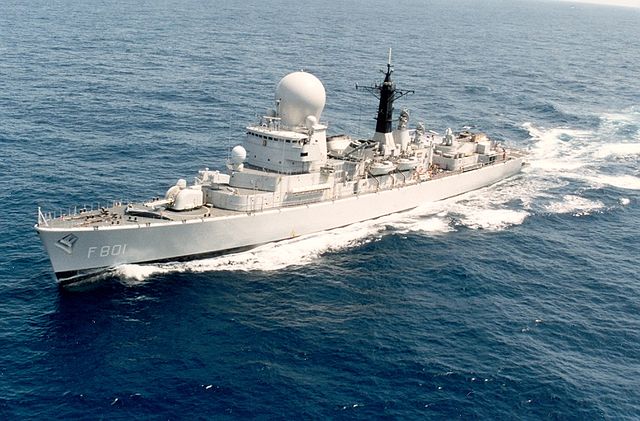
HNLMS Tromp circa 1995 (cc)
Certainly the most ambitious program in the Netherlands for a warship at that stage. These missile frigates had the task of replacing cruisers, those of the De Ruyter class. The idea should have seemed ludicrous 20 years ago, but missile technology went so far ahead that rather than the old “spray and prey” of conventional artillery, no longer relevant, a few missiles which accuracy was close to 100% could be carried by smaller vessels.
The staff requirements made in the 1960s stipulated they should be able to protect either a stak force or a convoy against both aviation and guided weapons, with sophisticated and compherensive command and control electronic facilities, but also ASW and anti-ship capabilities. In short, they were missile destroyers in disguise and indeed were often assimilated to these in publications of the time, despite their pennant, F801 and F802. One argument was political. It was easier for the admiralty to make “swallow the pill” to the diet (parliament) if labelled like a “light ship” such as a frigate. Destroyers like cruisers, sounds old-fashioned and costly.
General design
But in the end, they were indeed small enough to be frigates at the time, when missile destroyers were closing to 8-9,000 tonnes. The end specs asked for them to lead two of the three ASW task groups created in accordance to the 1974 naval plan. They were 30% longer and larger than the previous Van Speijk, with a flush-deck, roomy, tall freeboard hull and extensive superstructures, plus new powerful radars and communications suites, making them clearly appear as leding the pack indeed. The only concession to nostalgic of the old school were their unique 120 mm twin turret straight from previous Dutch destroyer HNLMS Gelderland, retired.
They looked only tailored for classic naval combat, but both because of their elevation and automation, they could be used also as AA guns. Their missile suite was comprehensive for such small ships, with no less than three systems: Long range SAM (Standard SM-1)*, short range SAM (Sea Sparrow) and antiship with two quad canisters SSM harpoons. The ASW suite comprised 324 mm triple TTs for close range and the very capable Lynx helicopter for long range. Antimissile systems were provided with illuminators and EEW systems plus two Corvus Chaff launchers. *At the origin, the British Sea Dart was designed for integration, but latter dropped due to dimensions issues, in favor of the US Tartar/Standard instead.
The original propulsion was to be composed of steam turbines but the need to spare room for extra ammunitions and weapons sytems forced the adoption of more compact COGOG systems instead. The Olympus turbines were downgraded to improve the gas generator life and reduced maintenance. Speed, at 28 knots was still compatible with the needs of the fleet, while ensuring a range of 5,000 nm which was the norm for NATO operations in northern Europe. They were also agile, with twin-spade rudders fitted with each its own electrohydaulic steering gear.
Reduction of noise was also a priority and so all machinery was resiliently mounted and silencers in uptakes and uptakes were installed. The entire achinery could be monitored from a single control room near the operation room. Ventilation and air conditioning was also installed while the ships were designed with NBC standards in mind. Both ships were built and delivered by KM de Schelde, Vlissingen, laid down in 1971, launched 1973-74 and completed 1975-76, a rather long construction tile contrasting with the previous Van Speijk class, but explained by the sophisticated systems onboard and difficut requirements based on the limited tonnage.
Modernisation
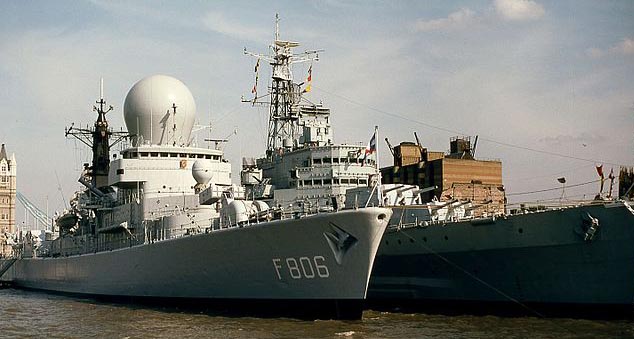
HNLMS Tromp in Belfast 1990s (cc)
The Dutch-designed and built SEWACO system was based on the DAISY-I computer suite and displays. In 1980, both ships, after barely five years of service, received plastic radomes fitted ove their main SPS-01 radar and in the 1980s, the RAMSES electronic system was set in place, basically an improved ECM suite. Four super SBROC chaff launchers replaced the old British Corvus.
In 1988 it was panned to adopt the new SMART 3 radar suite, but these plans were shelved in 1989 with the Berlin wall falling, and then back after the gulf crisis. Since, the ships had received a Super RBOC Chaff launcher, modernized ECM and CIWS antimissile systems. In the late 1990s they were scheduled for decommission, proposed to international sales, but failed to acquire any order, because of their initial high cost. They were decommissioned in 1999 and 2001 respectively.

Conway Profile of Tromp in 1975
Specifications
Dimensions: 131.4/138.2 m oa x 14.8 m x 6.6 m
Displacement: 3,665 tons standard, 4,308 tons full load
Powerplant: 2 shaft COGOG TM3B GT 44,000 shp, 2 RM1A GT 8,200 shp, 28 knots, Range 5,000 nmi at 18 kn
Armament: 2× 5-in guns, 1 SM-1 SAM, 1 Sea Sparrow SAM, 8 Harpoon SSM, 6x 324 mm ASWTTs, 1 Helicopter
Electronics: SPS-01, WM-25, SPG-51C, sonar CWE-610, Type 162
Crew: 306
 Kortenaer class missiles frigates (1976)
Kortenaer class missiles frigates (1976)
Kortenaer, Callenburgh, Van Kinsbergen, Banckert, Piet Hein, Abraham Crijnsse, Philips van Almonde, Bloys van Treslong, Jan van Brakel, Pieter Florisz.

HNLMS Kortenaer (F 807) of the kortenaer class in the 1980s (cc)
The Kortenaer class is quite famous in late cold war Europe, as it formed a “northern standard”, a new generation of specialized Anti-submarine frigates for the Royal Netherlands Navy, featuring COGOG (combined gas or gas) propulsion and and armament more specialized than the previous Tromp class. They were not boxing in the same category anyway, supposed to replaced the small Roodfier class of the 1950s. This was the largest order in Netherlands’s naval history woth no less than ten ordered and built by de Schelde in Vlissingen and Wilton-Fijenoord in Schiedam.
The entire program spanned only five years, between 1978 and 1982. In reality a grand total of 12 were built, but the last two were sold to Greece while still under construction (Elli class). Soon they were replaced by the two Jacob van Heemskerck-class frigates, essentially AAW variants of the Kortenaer class. In post-cold war budget restrictions environment, three more were later sold to Greece in 1993-95 and three more, plus the last two to UAE. They are no longer active in the NL navy. Eight very similar ships were built in Germany, known as the Bremen class and leading to the standard said above.
Development
Designed as replacement for the Holland and Friesland class destroyers, these 12 ships as planned initially, were the largest missile frigate program in continental Western Europe to that point. They were designed to be as cheap as possible, maximizing standardization, modularization, ease of maintenance and modernization, plus a common armament, shared electronics, and counting on mass construction effect over a short period. There were talked with UK to asso share a common hull, but discissions ended and the Dutch went on their way. The “standard” found in many publications however came from the fact the same ships were to be declined as ASW and AAW ships on a common basis. But it was limited to the Van Hermskerck class in 1983 (AAW version) eventually, making a 12 ship “standard”. The idea of multinational frigate standards will resurface in the 2000s in a joint effort between France and Italy notably, with more success as the large Horizon-class “standard” won the competition for the future USN Frigate recently. The name “standard” also related to NATO specifications for an Ocean escort frigate, matched to the rivet.
Design of the kortenaer class
Eiht were ordered in 1974, four in 1976 with a hull form reminiscent of French construction, continuous upper and main decks, single rudder of the semi-balanced type, clipper bow with negative sheer, and good performances obtained by a better lenght/width ratio. They were shorter and 40 cm slimmer than the Tromp class, with reduced superstructures and armament, for a total displacement of 3,700 tonnes FL versus 4,300. The next AAW class was even lighter. However at the same time, the COGOG arrangement was better, with the same olympus turbines butnot down-rated, so to provided 51,600 bhp instead of 44,000 (and 30 rather than 28 kts). They were coupled with two sets of British Tyne CM1 C gas turbines providing for cruise, 9,800 shp for 20 knots. Range was a bit less however. The ASW component comprised four single 324 mm modernized TTs, and two WG-13 Lynx helicopters with a proper hangar, a single OTO Melara 76 mm gun and a 40 mm or Goalkeeper CIWS 30 mm depending of the ship (plus two Corvus – later RBOC) chaff RL) and for overall defence, a short ranhe Sea Sparrow 1×8 ramp forward and for antiship defence, eight harpoons behind the main mast. The last of the class was completed in 1983. Apart the hul sonar, all electronics systems were Dutch.
Modernization and fate
They only served a bit more than ten years, the end of the cold war making a wave of sales. The first ships had a second 76 mm OTO on the hangar roof, later replaced on all ships by a much smaller 40 mm Bofors, and later CIWS. Like the previous Tromp class, they were planned to received the SMART-3D radar, and SQL-18A towed array, but these plans were shelved. Now Greece inherited no less than eight ships of the same type, quite a potent force which makes as of today the bulk of its frigate force, together with light MEKO class vessels.

Kortenaer as completed in 1978
Specifications
Dimensions: 121/130.2 m oa x 14.4 m x 6 m
Displacement: 3,000 tons standard, 3,785 tons full load
Powerplant: 2 shaft COGOG TM3B GT 51,600 shp, 2 Tyne TM1C GT 9,800 shp, 30/20 knots, Range 4,700 nmi at 16 kn
Armament: 1× 3-in gun, CIWS, 1 S.Sparrow SAM, 8 Harpoon SSM, 4x 324 mm ASWTTs, 2 Helicopter
Electronics: LW-08, WM-25, STIR-180, ZW-06, sonar SQS-505
Crew: 200
Jacob van Heemskerck class missiles frigates (1983)
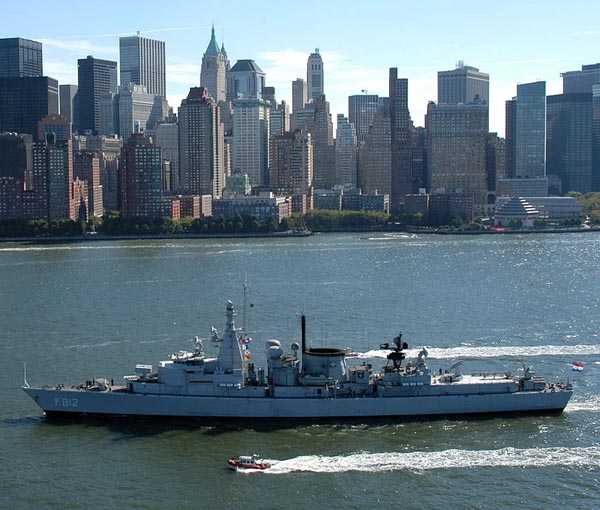
HNLMS Jacob van Heemskerck (F 812) (cc)
Jacob van Heemskerck, Witte de With
In the early 1970s, the Royal Netherlands Navy started to take advantage of its ‘Standard’ frigate, and decline an AAW or anti-aircraft version of it. Common machinery, electronics and sensors were planned, and in total, 12 ASW vessels planned to operate in the Atlantic, with a single AAW version acting as flagship for the third task group (to replace the former Van Speijk-class frigates), covering the English Channel and North Sea. In 1981, however, decision was built only two the AAW ‘Standard’ class as replacement, a 13th abandoned. Like the previous ships, they had a flush-decked hull, and identical COGAG machinery rated for 19,200 kilowatts (25,800 shp).
Of course the main difference would be in the armament, with a SM-1 medium range Mk 13 missile launcher aft with a 40-missile magazine; instead of the aft helicopter hangar and deck.
It was complemented with an octuple launcher Mk 29 NATO Sea Sparrow for short range forward (24 missiles carried) and from the start, a single Goalkeeper CIWS mounted aft, but no forward OTO Melara 76 mm gun. However the same canisters for eight Harpoon SSMs were kept at the same place as well as four tubes for Mark 46 torpedoes.
They had the same overall appearance for superstrctures but carried a Signaal LW-08 long-range air search radar, DA-05 target tracking radar, while the SM-1 SAMs were served by two STIR-240 director radars and the STIR-180 for the Sea Sparrow missiles forward. The ships were also equipped with a PHS-36 hull sonar. Laid down in 1981, they were completed in 1986. In the 1990s they received the new SMART-3 3D tracking radar indended for the Tromp class ships. Both were in service until 2005, resold to Chile. They were expected to be replaced by the new 2023 type Frigates.

Conway profile of the Hermskerck in 1989.
Specifications
Dimensions: Same
Displacement: 3,000 tons standard, 3,750 tons full load
Powerplant: Same
Armament: 1 SM-1 SAM, 1 Sea Sparrow SAM, 8 Harpoon SSM, 4x 324 mm ASWTTs, 30mm CIWS
Electronics: LW-08, DA-08, 4 STIR-180/240, ZW-06, sonar PHS-36
Crew: 197
Karel Doorman class (1988)
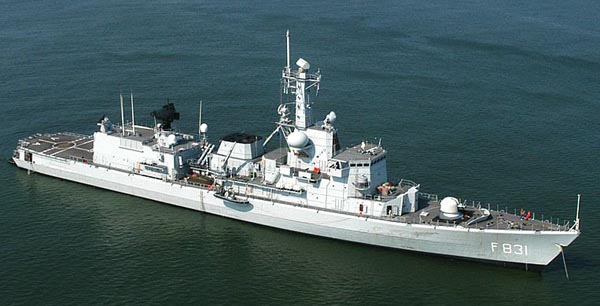
Karel Doorman, Willem van der Zaan, Tjerk Hiddes, Van Amstel, Abraham van der Hulst, Van Nes, Van Galen, Van Speijk
In the 1970s, the Roofdier-class frigates were scheduled for replacement, leading to the study of a “small” frigate type, later evolving into the future Karel Doorman-class. The new design was finalised from the basis of the Kortenaer class in the 1970s but refined based on new requirements in 1978, revied in 1980. Called the “M-frigates” they were designed in close collaboration with De Schelde Yard R&D cell in Vlissingen, but also the design agency Nevesbu. For the first time, stealth was integrated into the design, with sloping walls and special coating. Facilities for the reduced crew, only 150, was refined, notably to intregrate more privacy for mixed personal and improved comfort.
The Karel Doorman-class were multi purpose frigates, reflected in their armament able to deal with AAW and ASW threats. They also had light armament to deal with anti-drug and piracy operations. Yhey were still armed with Harpoon and sea sparrown missiles, 324 mm TTs and RBOC Chaff launchers. HNLMS Karel Doorman was laid down in February 1985, launched in April 1988, so she belongs for her development to this cold ar section. She was hoever commissioned after the fall of the USSR, and the start of the Gulf war, in May 1991.
At some point, Dutch authorities tried but failed to negiotate foreign purchases, but they eventually obtained those in the 2000s with the Belgian, Chilean, and Portuguese navies. Despite their small size and powerful armament, they still kept a hangar with a single Westland Lynx helicopter, armed with two Mk 46 torpedoes, dipping sonar and infrared systems for night patrols.

Conway Profile of the Karel Doorman design, 1991
Specifications
Dimensions: 114.4/122.3 m oa x 14.4 m x 6.1 m
Displacement: 2,800 tons standard, 3,320 tons full load
Powerplant: 2 shaft COGOG RR SM1 Spey 37,500 shp, 2 SW SWD 280 V12 diesels 8,450 shp, 30/21 knots, Range 5,000 nmi at 18 kts
Armament: 1 Sea Sparrow SAM, 8 Harpoon SSM, 1x 76mm, 4x 20mm, 1 CIWS, 4x 324 mm ASWTTs, 1 Helicopter
Electronics: LW-08, SMART, 2 STIR-180, sonar PHS-36, DSBV- 61A
Crew: 154
Future NL FF 2023
In the 1990s a “projected guided missile frigate” was in the studies. The strong point of its design is its use of the VLS Mark 41 SAM, launching the Evolved Sea Sparrow. It was completed by a panoply of eight Harpoon SSM missiles, a 127 mm gun for the first time, CIWS and 20 mm AA, individual ASW TTs and the new NH-90 helicopter. Electronics-wise it was to use the new SMART-L radar, APAR combat system and a new gen. hull mounted sonar by Thomson-sitra, using TNO-FEL ALF combination with twi 130 m flexible towed receiver arrays. As second medium to long range SAM was considered. Even the propulsion was advanced, with an intercooled recuperative gas turbines and COGOG configuration. The project was for a 4,400 tonnes vessel, but it evolved into a much heavier one: The actual De Zeven Provinciën class (2002) planned back in the early 1990s to replace Tromp and De Ruyter: Using the same name, four 6,000 tonnes ships, again destroyers in disguise were started in 1998, now at the head of the Dutch fleet: De Zeven Provinciën, Tromp, De Ruyter and Evertsen, commissioned for the latter in 2005.
Their own replacement is planned for 2025 at the earnest, and in 2020 it was announced together with the Bundesmarine, a common platform design to replace both the Sachsen-class frigates and De Zeven Provinciën-class frigates from 2030. Indeed, replacement for the M-class or “light” frigates of the Doorman class are since 2017 called Anti-Submarine Warfare Frigate (ASWF) and planned to be developed jointly with and for the Belgian navy as well. The program was started in 2013 but in 2017 it reached a new milestone as Belgium engaged to built four of these, the Dutch themeslves being committed to at least four. But all this is out of our field of study, which is the cold war.
Cold war Dutch submarines
 Dolfijn class (transferred 1948)
Dolfijn class (transferred 1948)
Dolfijn, Tijgerhaai, Zeehond, Zwaardvisch
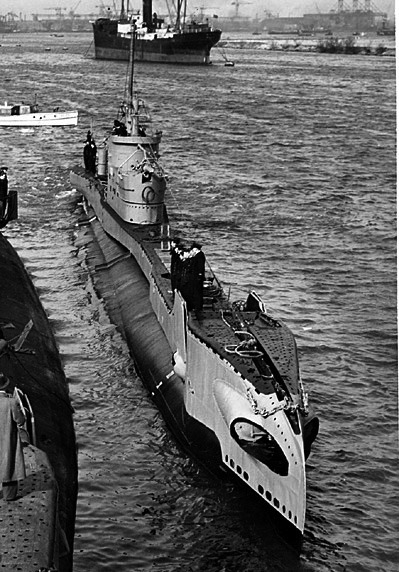
The T class HMS Taurus and HMS (laid down 1941, launched June 1942) already had a significant WW2 career. Whe transferred to the Dutch fleet, the idea was to provide crews with an updated design, before the local industry was able to deliver proper vessels. They were not modernized, being left “in their juice” all their career. So specs as the very same as the British T class. They had been designed as ocanic submarines but not yet as long range as the Pacific “A” class which never saw WW2.
Taurus served in the Mediterranean and Pacific, sinking about 50 ships and boats. Surviving, HMS Taurus was transferred to the Royal Netherlands Navy on 4 June 1948. She was recommissioned the same day, renamed Dolfijn. HNLMS Dolfijn would have a relatively quiet career,, with just a few training cruise before decommission on 7 November 1953, transferred back to the Royal Navy, and recomm. again as Taurus on 8 December 1953, with seven more years with the RN before being scrapped in April 1960.
On her side, not commissioned into the Royal Navy as HMS Tarn, the second transferred T class was instead directly passed on to the Royal Netherlands Navy during WW2, commissioned on 28 March 1945 as Tijgerhaai. She had a relatively but tied up inboard of HMS Sidon when she suffered a torpedo malfunction and sank. On 19 October 1955, she ran aground in Weymouth Bay. She was decommissioned on 11 December 1964, sold for BU.
HNLMS Zeehond was the ex- HMS Tapir, also a veteran of WW2, launched on 21 August 1944 and after commission, torpedoing the German submarine U-486 in the North Sea off Bergen (Norway) in April. On 18 June 1948, surplus to requirements, like Dolfijn she was loaned to the Netherlands for five years, recomm. on 12 July 1948. She visited Curaçao in 1949 and helped making gravity measurements and a long snorkel trip on the way back. Retransferred to the RN on 15 July 1953 she served as HMS Tapir from 16 December 1953 to December 1966.
HNLMS Zwaardvisch started as HMS Talent, Launched on 17 July 1943 but never comm. in the RN and directly transferred to the Royal Netherlands Navy on 23 March 1943. She went on to lead a distinguished career in the Pacific (see dutch ww2 subs), and after the war, apart from a voyage to the Dutch West Indies in 1947, her career was quiet. She was renamed Zwaardvis in 1950 and decommissioned on 11 December 1962, BU the next year.
 Walrus class (transferred 1953)
Walrus class (transferred 1953)
Walrus (ex-Icefish), Zeeleuw (ex-Hawkbill)
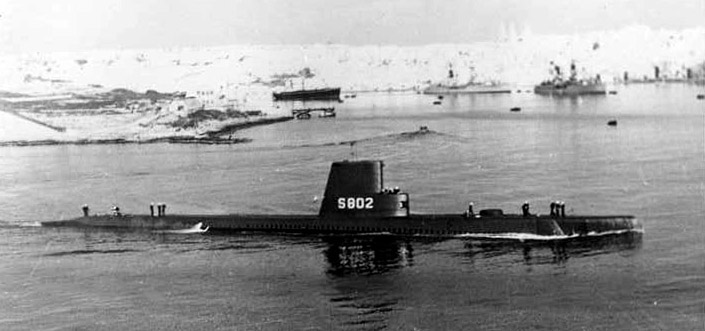
The lead ship, HNLMS Walrus, was one of several ex-Gato class submarines transferred in 1953 to the Dutch Royal Netherlands Navy after conversion as GUPPY Ib. So they were far more modern, fast and spacious than the British T class. These were former USS Icefish (S802) and USS Hawkbill (S803) built in Maniwotoc, and funds were secured via MDAP.
Icefish twas decomm. in Groton, Conn. on 14 July 1952 and decommissioned on 29 July 1952 as a GUPPY IB conversion, recomm. on 10 December 1952, conducting tests until transferred to the Netherlands, recommissioned as HNLMS Walrus by 21 February 1953.
After a quiet service, she was formally returned to US Navy custody and discarded on 15 July 1971, sold.
Similiar contruction and career in WW2 alredy, USS Hawkbill was converted and transferred to the Netherlands on 21 April 1953, then sold to the NL fleet on 20 February 1970 to be discarded and BU on ite rathe than being returned to the US. Both submarines had been an important upgrade for the DRNN, for the first time operating proper “submarines” which performances were equivalent to the Soviet “Whiskey”.
Specs Guppy Ib
Dispacement: 1830/2440 tons, Dimensions 93.6 x 8.20 x 5.20
Propulsion: 2 shafts, 4 GM diesel-generators + 4 electric motors 4610/5400
Performances: 18/15 kts (7.5 with snorkel) 378/472 diesel oil for 11,000 nm 10 kts, 96 sub.
Armament: 10 x 533 TT (24 torpedoes or 40 mines, 6 bow, 4 stern)
Electronics: SS, SV, BPS-1 radars, BQR-2, BQS-2, JT or SQR-3 sonars, APR-1 ECM suite
Crew: 82
Diving depth operational: 120m
 Dolfjin (ii) class (1959)
Dolfjin (ii) class (1959)
Dolfijn, Zeehond, Potvis, Tonijn
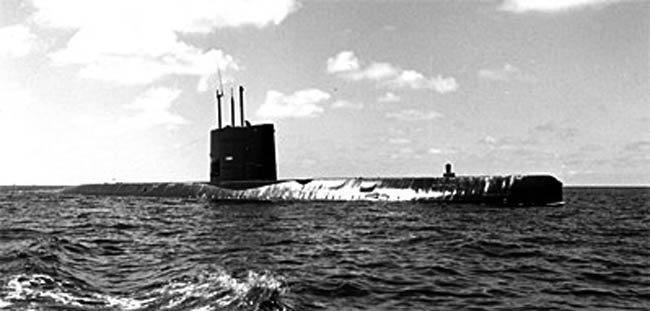
This class is important as the first new locally built submarine serie since the late 1930s. The design was worked out in the 1950s based on NATO-compatible specifications as a mix of several contemporary in Rotterdamse Droogdok Mij and Wilton-Fijenoord, Schiedam. A whole article will be dedicated to them. The class comprised HNLMS Dolfijn (S808), launched 20.5.1959, comm. 16.12.1960, Zeehond (S809) launched 20.2.1960, comm. 16.3.1961, Potvis (S804) launched 12.1.1965 comm. 2.11.1965 and Tonijn (S805) launched 14.6.1965 and comm. 24.2.1966.
Although smaller and light than the GUPPY, with a reduced crew their construction allowed to dive twice deeper. They received Dutch electronics and served for the the whole cold war, being decommissioned from 1990 to 1994, the last kept as a museum.
Design-wise, they were very versatile: The so-called Three-Cylinders, instead of one or two pressure hulls, they had three separate pressure hulls, cylinders arranged in a triangle, enclosed in an external steel casing separates the inside. This allowed them to dive deeper with better stability but needed more machinery and crew maintenance and control. The upper hull was reserved for living and working quarters, the two lower hulls hosted the engines, batteries and storage rooms. Designer was Max F. Gunning, based on a never built project to resupply Malta in WW2.
Nuclear propulsion was envisioned for the second batch (“Potvis class”) but postponed to study feasibility, but dropped afterwardsn and completion was made as diesel-electric models. Zeehond was converted into a trials ship by Rotterdamsche Droogdok Maatschappij shipyard in Rotterdam in 1990, technology demonstrator for closed loop diesel AIOP until 1994.
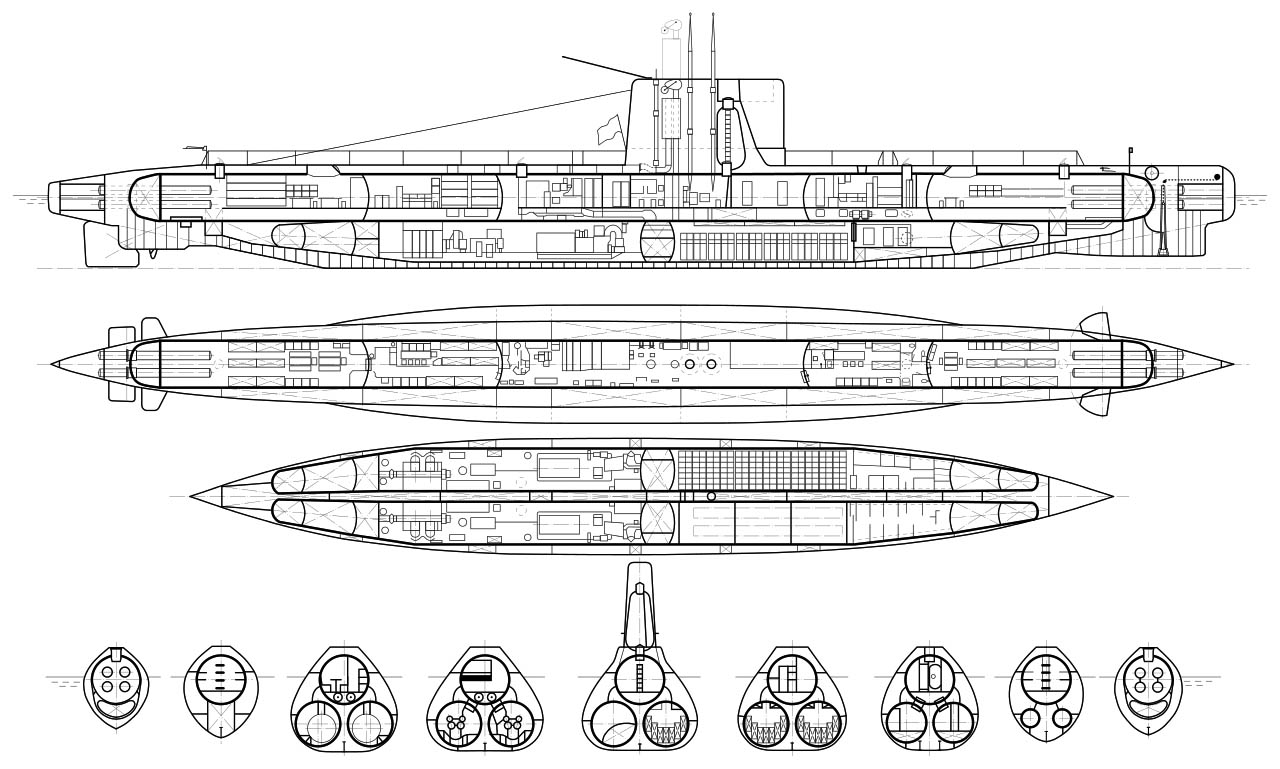
Specs Dolfijn
Dispacement: 1,520/1,830 tons (S808) and 1,509/1,831 (S804)
Dimensions 78.3/79.5 x 7.90 x 5m
Propulsion: 2 shaft MAN 12-V6V 22/30 diesels/2 electric motors 2800/4000 hp
Performances: 14.5/17 kts
Armament: 8 – 533 TT (4 bow, 4 stern, 20)
Electronics: ZW-06 radar, sonars, ECM suite, M8 CCS
Crew: 64
Diving depth operational: 300m
 Zwaardvis class (1970)
Zwaardvis class (1970)
Zwaardvis, Tijgerhaai (+2 exports)
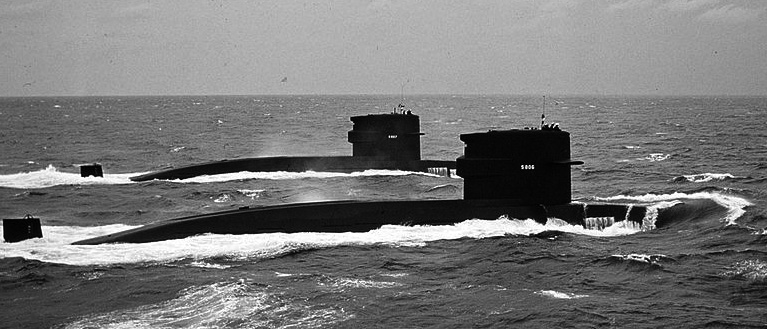
The Zwaardvis-class submarine (“Swordfish”) were conventional attack submarines built in the late 1960s to 1970s, a class of ony two boats, very modern compared to the previous singular design, with a conventional layout and tearpdrop shaped hull.
Two more were built at Rotterdamsche Droogdok Maatschappij between July 1966 and August 1972 and two more later at Wilton-Fijenoord for the ROCA Navy (Taiwan/Republic of China) as the Hai Lung class (December 1982-October 1987/April 1988), still in service today.
Design-wise, they were very ambitious and modern boats, the result of ten years of research and development by all major players in the Netherlands at the time, RDM, Wilton-Fijenoord, De Schelde and NDSM, as well as Werkspoor N.V. and N.V. Nederlandsche Vereenigde Scheepsbouw Bureaux. The one cylinder, two stage, resulted in more space within the submarines for more spacious accommodation coupled with greater automation. Maintenance costs so were lesser, and machinery service was made easier.
They were loosely based on the U.S. Navy Barbel class with the typical teardrop hull design, less noisy, single propeller, more, quieter and suspended diesel engines, more modern, faster loading batteries and more versatile weapons systems as the tubes enabled missiles and torpedoes (Mark 37 notably) launched from greater depths. Diving depth was beyond 350m, and from 1988, Mark 48 torpedoes were adopted. Electronics were Dutch and state of the art, combined with the advanced Sonar Elodone Octopus and the type 20026 towed array plus the NATO “classic” DUUX-5.
Their service life was relativey short and the pair was deactivated in 1994-95. A new pair of moder modern subs, the Walrus, plus another pair (Dolfijn (iii)) ten years later, after the cold war, currently forms the NL Marine submarine force.
Specs Zvaardvis
Dispacement: 2,408 tonnes surfaced, 2,640 tonnes Submerged
Dimensions 66.9 x 8.4 x 7.1 m (219.6 x 27.7 x 23.4 ft.in)
Propulsion: 1 shaft, 3 × diesels, 4,200 hp (3,100 kW), Holec ELM 5,100 hp (3,800 kW)
Performances: 13/20 kn (24 km/h; 15 mph/37 km/h; 23 mph) surfaced/sub
Range: 10,000 nmi (20,000 km) at 9 knots (10 mph; 17 km/h)
Armament: 6 – 533 TT (6 bow, 20)
Electronics: radar type 1001, Sonar Elodone Octopus, type 20026 towed array, DUUX-5ZW-06 radar, sonars, ECM suite, M8 CCS
Crew: 67
Test depth: 220 m (720 ft)
 Walrus class (1985)
Walrus class (1985)
HNLMS Walrus, Zeeleeuw (post cold war Dolfijn, Bruinvis)
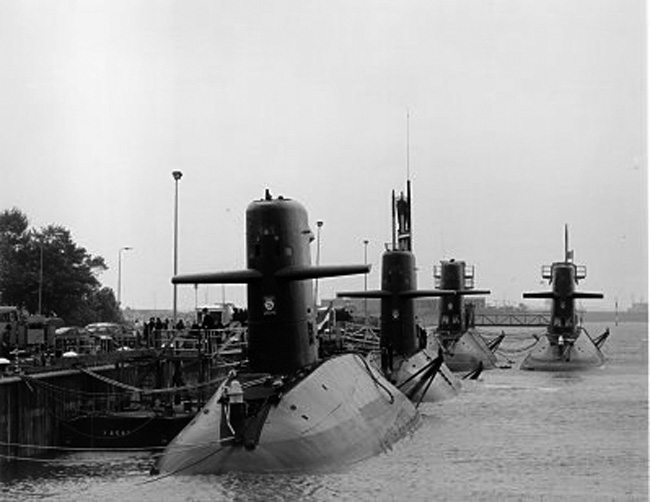
These post-cold war subs are listed here since the first two were studied in the late 1970s as an improved version of the Walrus, with the rocky development: HNLMS Walrus (S802) was laid down on 11 October 1979, launched 28 October 1985 and then completely modified, drydocked and re-launched on 13 September 1989 and then commissioned on 25 March 1992, so after the end of the cold war. Her sister ship HNLMS Zeeleeuw (S803) was started two years later on 24 September 1981 on a modiied design, with many afjustments making for a late launch on 20 June 1987 and completion on 25 April 1990 so arguably before the end of the cold war (the end of USSR was announced technically on December 25, 1991). The design was further improved afterwards, leading to two follow-up vessels, HNLMS Dolfijn (S808), started on 12 June 1986, launched 25 April 1990 and completed on 29 January 1993 and HNLMS Bruinvis (S810) started on 14 April 1988, launched 25 April 1992 and completed on 5 July 1994 to replace the Zvaardvis class. All at Rotterdamsche Droogdok Maatschappij.
Design-wise, they were unusual with their cross-shaped stern diving planes and rudders, first tested in 1960 by USS Albacore, and ported on the Walrus class, Swedish Sjöormen class, RAN Collins class, German Type 212A and Japan’s Sōryū class. This complex is rarely seen otherwise as quite complex.
When submerged, this new generation was to be super silent and they were setup for the same large variety of mission a nuclear sub could, including electronic spying and specops. They enforced a maritime blockade during the Yugoslav Wars. Specifically designed for hunting Russian submarines they provided excellent services in various international conflicts and are still part of international exercises withing NATO framework, with an excellent reputation. No export yet not replacement programmed, but updates.
Specs Walrus
Dispacement: 1,900 t standard, 2,350 t/2,650 t surf/sub
Dimensions: 67.73 x 8.4 x 6.6 m (222.2 x 28 x 22 ft)
Propulsion: 3 diesels diesel-electric 5,430 shp (4 MW), 1 shaft 5 bladed prop.
Speed: 13 knots (24 km/h) surfaced, 20 knots (37 km/h) submerged
Range: 18,500 km (10,000 nmi) at 9 kn (17 km/h)
Test depth: 300 m (980 ft)
Complement: 50-55
Electronics: Signaal/Racal ZW 07, Thomson Sintra TSM 2272 Eledone Octopus, GEC Avionics Type 2026 towed array, Thomson Sintra DUUX 5 passive ranging and intercept
Armament: 4 × 21-inch (533 mm) TTs (20 Mk 48/NT 37 torpedoes), mines, UGM-84 Harpoon SSM)
Cold war Dutch Corvettes and Misc.
Ternate class corvettes (transferred 1946)
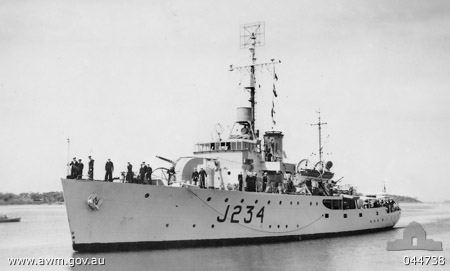
HMAS Latrobe of the Bathurst Type
Former WW2 Bathrurst class minesweepers (launched 1941), in Australian service, were acquired in 1916 and the KNIL was desperate to reconstitute its forces top face insurrection in the far east. They were all transferred directly to the east indies and used as patrol ships. They were the HMDS Ternate (ex-Kalgoorie), Batjan (ex-Lismore), Boeroe (ex-Toowoomba), Ceram (Burnie), Amban (Cairns), Banda (Woolongong), Morotai (Ipswitch), and Tidore (Tamworth). They kept their WW2 armament minus the minesweeping gear, removed. In the 1950s they were modernized with a single 105 mm mount to replace the former twon-4-in.
They were discarded in 1958 but four were transferred after the Dutch departed to the newly formed Indonesian Navy.
MMS/BYMS class Minesweepers (transferred 1948)
Seven ex-British wooden MMS of 255t (launched 1943-44) were operated until disposed of 1949-52: Duiveland (MV 13), Overflakkee (MV 14), Schok land (MV 15), Tholen (MV 16), Voorne (MV 17), Wieringen (MV 19) and Ijsselmonde (MV 20) which saw service with the KNIL in the east indies. Duiveland and Ijsselmonde were transferred to Indonesia in the late 1950s and the remainder were broken up.
There were also ten BYMS type vessels of 223t: Borndiep, Deurloo, Hollandsch Diep, Marsdiep, Oosterschelde, Texelstroom, Vliestroom, Volkerak, West erschelde and Zuiderdiep for the Eureopan fleet. They were numbered from MV 34 to MV 43 respectively (changed in 1950 to NATO numbers M 831-840). In the late 1950s Zuiderdiep, Borndiep, Marsdiep, Deurloo and Vliestroom became diving vessels and were renumbered A 904-906, A 921 and A 922 respectively. The unconverted ships were disposed of in 1958 and the diving vessels followed in 1962 .
Eight MMS type minesweepers (219t) were operated until 1958 (except Vlieland, sunk New Guinea 1951): Ameland, Beveland, Marken II, Putten, Rosenburg, Terschelling, Texel and Vlieland. They were initially numbered MV 5-12, and were later given the NATO numbers M 861-867. Four prewar Netherlands – built minesweepers (460t, launched 1936-37) were employed as patrol and gate vessels: Abraham Crijnsson, Abraham Van Der Hulst, Jan Van Gelder and Pieter Florisz. Initially numbered MV 1-4, they were later given the numbers A 925-928. They were stricken in 1962 .
Coastal Minesweepers
DJEMBER auxiliary minesweepers (1941) Built for the KNIL at Soerabaja Droogdok Mij, Surabaya, these ships were either lost, captured during the war. Only a few survived, passed on by the Japanese to Indonesia in 1950: Djember, Djombang, Digoel, Djampea, Enggano, Endeh, Flores, Fakfak, Grissee, Garoet.
TEXEL motor minesweepers (1942-1943) Built in J. W. & A. Upham, Brixham, UK, Wivenhoe Shipyard, Herd & McKenzie, Buckie, Husband Yacht Yard, Marshwood, Frank Curtis, Par, J. L. Bolson, Poole, and East Anglian Constructors, Oulton Broad as BMM (wooden hull) for the RN, replacement for the armed trawlers and very successful ships built in civilian yards, fitted with acoustic detection and mines. Transferred during the war and renamed. The class comprised the Texel (ex-MMS173), Terschelling (ex-MMS174), Marken (ex-MMS227), Ameland (ex-MMS231), Beveland (ex-MMS237), Marken (ex-MMS54), Putten (ex-MMS138), Rozenburg (ex-MMS292), Terschelling (ex-MMS234) Texel (ex-MMS73) and Vlieland. Terschelling was sunk in 1942, Marken in 1944, one postwar in 1951 (Vlieland) and the remainder were discarded in 1957.
THOLEN motor minesweepers (1943-1944) Improved version of the 105ft MMs built in UK, transferred postwar. They were renamed Duiveland (ex-MMS1074), Overflakkee (ex-MMS1046), Schokland (ex-MMS1082), Tholen (ex-MMS1014), Voorne (ex-MMS1043), Walcheren (ex-MMS1022), Wieringen (ex-MMS1025) and Ijsselmonde (ex-MMS1026). Various fates: Walcheren was sunk 19.11.1946, the rest were discarded 1949-54 apart Ijsselmonde which went to Indonesia in 1952. They all served with the KNIL.
HOLLANDSCH DIEP motor minesweepers (1942-1943) Transferred 1946-47.
AMBON minesweepers / frigates (1941 – 1942 / 1946)
ONVERSAAGD ocean minesweepers (1954-1955)
DOKKUM coastal minesweepers (1955-1957)
ALBLAS inshore minesweepers (1960-1962)
ALKMAAR minehunters (1983 – 1989)


 Latest Facebook Entry -
Latest Facebook Entry -  X(Tweeter) Naval Encyclopedia's deck archive
X(Tweeter) Naval Encyclopedia's deck archive Instagram (@navalencyc)
Instagram (@navalencyc)





 Austrian Navy
Austrian Navy French Navy
French Navy Royal Navy
Royal Navy Armada Espanola
Armada Espanola K.u.K. Kriegsmarine
K.u.K. Kriegsmarine Dansk Marine
Dansk Marine Nautiko Hellenon
Nautiko Hellenon Koninklije Marine 1870
Koninklije Marine 1870 Marinha do Brasil
Marinha do Brasil Osmanlı Donanması
Osmanlı Donanması Marina Do Peru
Marina Do Peru Marinha do Portugal
Marinha do Portugal Regia Marina 1870
Regia Marina 1870 Nihhon Kaigun 1870
Nihhon Kaigun 1870 Preußische Marine 1870
Preußische Marine 1870 Russkiy Flot 1870
Russkiy Flot 1870 Svenska marinen
Svenska marinen Søværnet
Søværnet Union Navy
Union Navy Confederate Navy
Confederate Navy Armada de Argentina
Armada de Argentina Imperial Chinese Navy
Imperial Chinese Navy Marinha do Portugal
Marinha do Portugal Mexico
Mexico Kaiserliche Marine
Kaiserliche Marine 1898 US Navy
1898 US Navy Russkiy Flot
Russkiy Flot French Naval Aviation
French Naval Aviation Russian Naval Aviation
Russian Naval Aviation Sovietskiy Flot
Sovietskiy Flot Royal Canadian Navy
Royal Canadian Navy Royal Australian Navy
Royal Australian Navy RNZN Fleet
RNZN Fleet Chinese Navy 1937
Chinese Navy 1937 Kriegsmarine
Kriegsmarine Chilean Navy
Chilean Navy Danish Navy
Danish Navy Finnish Navy
Finnish Navy Hellenic Navy
Hellenic Navy Polish Navy
Polish Navy Romanian Navy
Romanian Navy Turkish Navy
Turkish Navy Royal Yugoslav Navy
Royal Yugoslav Navy Royal Thai Navy
Royal Thai Navy Minor Navies
Minor Navies Albania
Albania Austria
Austria Belgium
Belgium Columbia
Columbia Costa Rica
Costa Rica Cuba
Cuba Czechoslovakia
Czechoslovakia Dominican Republic
Dominican Republic Haiti
Haiti Hungary
Hungary Honduras
Honduras Estonia
Estonia Iceland
Iceland Eire
Eire Equador
Equador Iran
Iran Iraq
Iraq Latvia
Latvia Liberia
Liberia Lithuania
Lithuania Mandchukuo
Mandchukuo Morocco
Morocco Nicaragua
Nicaragua Persia
Persia San Salvador
San Salvador Sarawak
Sarawak Uruguay
Uruguay Venezuela
Venezuela Zanzibar
Zanzibar Warsaw Pact Navies
Warsaw Pact Navies Bulgaria
Bulgaria Hungary
Hungary

 Bundesmarine
Bundesmarine Dutch Navy
Dutch Navy Hellenic Navy
Hellenic Navy Marina Militare
Marina Militare Taiwanese Navy
Taiwanese Navy Chinese Navy
Chinese Navy Indian Navy
Indian Navy Indonesian Navy
Indonesian Navy JMSDF
JMSDF North Korean Navy
North Korean Navy Philippines Navy
Philippines Navy ROKN
ROKN IDF Navy
IDF Navy Royal New Zealand Navy
Royal New Zealand Navy Egyptian Navy
Egyptian Navy South African Navy
South African Navy

































 RN
RN
 Marine Nationale
Marine Nationale
 Soviet Navy
Soviet Navy
 dbodesign
dbodesign